L. Andrew Cooper's Blog, page 7
February 7, 2024
Interview with Filmmaker Michelle Iannantuono: Livescream and Livescreamers
 Premieres FREE on YouTube 2/10/24!
Premieres FREE on YouTube 2/10/24!Every day, over 200 loving fans watch Scott Atkinson play horror games online. After a lifetime of failures and false starts, streaming games is the only thing he’s good at. It’s the thing he loves the most. Until it becomes a nightmare. Enter Livescream—a mysterious horror game sent to him by an anonymous fan. At first, he thinks the game is a low-quality indie title. But when his followers start dying one by one, he soon realizes the game is far more sinister. Now, Scott will be forced through nine levels of video game hell, each level representing a different horror game niche, in order to walk away alive. It might just cost him his fans, and his soul, in the process.
Livescreamers Coming May 2024! Click for the trailer!
Coming May 2024! Click for the trailer!In this sequel to 2020’s Livescream, a popular group of content creators face the ultimate lesson in teamwork when a haunted video game begins killing them one by one.
The Interview1. Streamscreen. Livescream mimics a streaming experience, splitting the screen into areas where the audience can see Scott, the game player who talks to his stream’s viewers, in the upper-left corner, his viewers’ text-based commentary in the lower-left corner, and the game Scott is playing on the right. The story unfolds in all three areas and through their interactions. While the form makes sense for the content, the split-screen approach is unusual and got me thinking about films as different as Carrie (1976) and Timecode (2000). What inspired your approach? It seems risky because it demands more from the audience—how does the film manage the audience’s cognitive workload? How do you think managing information from three sources (in three media: video, text, and digital animation) affects the viewers’ responses in terms of fear and horror? How do you think the film’s form plays post-COVID, a time when, thanks to the rise of platforms like Zoom, people are more accustomed to split-screen/multimedia communication interfaces?
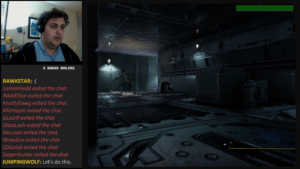
MI: It was really important to be aware of “eye tracking” during the editing of Livescream, which is a technique best demonstrated in movies like Mad Max Fury Road. There are a lot of cool video essays and literature about this, but essentially, you want to anticipate where you are pulling the audience’s eye from moment to moment and ensure there is good flow.
Plus, even though the story is divided between chat, gameplay, and Scott, there is only ever one essential thing happening on screen at any given time. In terms of managing horror, it is a way to pull some visual sleight of hand. For instance, most people cite that they never realize Scott gets up and leaves frame, because they’re too busy watching all the viewers leave the chat in that moment. It’s a bit easier to pull off scares in the game when they happen immediately after distracting the audience with the chat.
Finally, it is interesting to think about the impacts of COVID on screenlife, good and bad. On one hand, I feel like the market has been deluged with “in screen” movies, and I have faced some hurdles in marketing the sequel, Livescreamers, post-COVID. I get a lot of comments that no one wants another “Zoom Movie” even though both films are massively more ambitious and stylized than a simple video chat. However, having other comp titles is a bit of a strength. Back during 2018, I had few movies to really compare Livescream to, which made it hard to describe to people.
2. Longstream. Speaking of Livescream’s experimental form, Scott’s video portion of the narrative (with a brief exception) takes place in real time in his corner of the screen as if it were from an uninterrupted run of a webcam. In other words, as a movie unto itself, Scott’s portion might join the “single take” horror/thriller tradition, the most famous member of which is Hitchcock’s Rope (1948), a more recent example of which is Silent House (2011). Both of those movies faked it. Is Scott’s portion an uninterrupted, single take? If so, why was getting that take important enough to go to the trouble, and how much trouble was it? If not, why was the effect important enough to simulate, and how did you pull it off?
MI: It is faked by stitching three takes (again, stitched the two times he exits frame and comes back), although the middle take was a long, uninterrupted 35 minutes. I think this was really important to simulate because we’re supposed to be doing a livestream on Twitch. Those would be uninterrupted and done in real time, inherently.
3. Streaming Countdown. Another horror tradition in which you could position Livescream is the body count film, the slasher or mutations of the slasher such as Saw (2004) that, like Livescream, have victims “dying one by one.” In what ways do and don’t you see Livescream using, and perhaps playing with, slasher conventions? Which do you think are scarier, the glimpses of violence we catch onscreen or the moments of violence we catch by implication? Why?
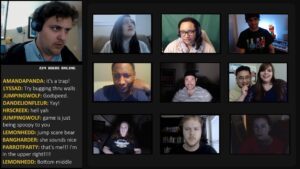
MI: It is nice to see it recognized as a slasher, as a lot of people miss that. It gets classified more often as tech horror, found footage, screenlife, etc, but at its core, it is a slasher. Scream is one of my favorite horror films, and I always borrow a lot from that movie’s plot progression. You have to cross into Act 2 with a body that the main characters know about. You have to have a consistently dwindling cast, although you also have to have some moments where your characters eke out of a set piece alive – otherwise every set piece becomes a repetitive and suspenseless endeavor where you know they’re doomed.
The limited onscreen violence is mostly a result of budget and format – you just don’t really see your followers’ faces, as a content creator – but I think it worked out for the best. Scott has a moment at the end where he finally sees the faces of the folks he lost, including someone who was a dear friend, and that’s pretty emotionally impactful, I think. Wouldn’t have been the same had you seen the blood spray earlier or known what these guys had looked like. I had to kill one of them on screen in order to sell the idea that the game was actually killing people, but beyond that, the film is deliberately vague.
I’ve lost a lot of internet friends over the years who just kind of vanished from social media or LiveJournal or whatever out of the blue, and I still to this day wonder what happened to them. There is definitely something haunting about not having answers to the fates of your online friends.
4. Screaming Countdown. The diminishing numbers of the living in Livescream are also diminishing numbers of Scott’s followers, and much of the drama and suspense in the film surround Scott’s relationships with those followers, as they are his social lifelines and the keys to the only activity that gives him fulfillment. How does your film reflect on people’s relationships with online personalities and those personalities’ relationships with their followers? How much of the horror comes from the psychological impact of Scott’s crumbling community and the way he diminishes along with his numbers?
MI: Livescream is a rather optimistic look at online community, as I was on the fan side of things at the time. I was inspired by how people found solace and friends within fandoms, rallying around a creator to make connections. Even Scott’s relationship with his mod, JumpingWolf, is an emotional core to reinforce the idea that a follower/creator relationship can be really pure and inspiring, and it doesn’t always have to be a toxic parasocial hellscape.
Part of the horror of losing these followers is because Scott genuinely recognizes and cares about them as people. He is a smaller streamer who is not really depending on this following for income or enterprise. To see them harmed because of his stream is deeply disturbing to him because he has felt like he has a bit of responsibility for his community all this time, creating a safe space for the lonely misfits of the world, and that space becomes immediately unsafe when playing Livescream. Losing this one thing he loves so much is pretty horrific when you realize all this guy wanted was community.
The sequel Livescreamers is a total inversion, showcasing what happens to the relationship between community and creator when it does become a business relationship. When fans equal income, when clout equals better business, and when creators ascend into idols. It was a reflection of my life after years of becoming a creator myself, having my own audience and experiencing invasive dynamics, as well as navigating the waters of asking for money in an ethical way.
5. Streaming Archives. The film we see is (mostly) Scott’s page for streaming his game-playing, which might very well be archived, so it could be an internet artifact we as viewers have stumbled upon—the online equivalent of found footage (if you’ll forgive me—found footage 2.0). In what ways do and don’t you see Livescream using, and perhaps playing with, found footage horror conventions? At least since The Blair Witch Project (1999), found footage films have been tied to internet-supported lore. The seemingly predatory game within Livescream, also called Livescream, may well be the gaming world’s answer to Slenderman. What, if anything, does Livescream have to say about internet artifacts and internet lore?
MI: I always thought it would be fun if MatPat got ahold of the film and broke it down in one of his Game Theory/Film Theory episodes. I suppose that’s really all of it – more than commenting on creepypasta or internet lore directly, the film features some aspects that could have been bait for folks who are into that sort of thing to take and run with. What is the Siren? Why is the game doing this? These are questions that don’t really have good answers – albeit somewhat elucidated in Livescreamers but still not too literally. They’re mostly fun carrots for folks to chew on in a Reddit thread. Borderline ARG, if you will!
For Livescreamers, we also have janusgaming.com which is an “in universe” website for the characters. I post in-character reels on the social media for Janus Gaming too. Just a bit of a fun way to expand the world and let the audience get to know the characters like they’re real humans.
In terms of found footage conventions, I don’t think I borrowed much. For a long time, people thought it had to be Cloverfield or Blair Witch adjacent to be found footage – shaky cam, shot on tape, narrator cameraman. Screenlife was a bit burgeoning in 2018, although The Collingswood Story and Unfriended had broken ground. But in a lot of ways, Livescream and Livescreamers do a lot of new things that no one else has (or had). Livescream is one of the first movies – I think – to incorporate some sort of “chat” element, which is now pretty popular with movies like Spree, Deadstream, Chad Gets the Axe. There aren’t many found footage films that incorporate gaming, sans Deadware. But what all these movies have in common is immense creativity, and that’s really the heart of the genre. If there’s a convention I love about found footage, it’s the constant opportunity to do something innovative.
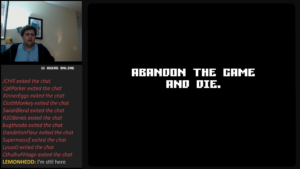
6. Indie Scream. The game within the film goes through different phases and styles of varying graphical quality. At one point Scott comments on graphics getting an “upgrade,” but he refers to the graphics in general as being “indie,” meaning low-quality. To me, they look like older—let’s say “vintage”—game graphics, and they go well with music (both diegetic and extra-diegetic) with a vintage edge. Why does the game go through different vintage styles, and why did you choose (if you agree with my characterization) a vintage aesthetic? Do you think there’s something scarier about a less sophisticated gaming interface? Why or why not?
MI: Well, that’s low budget for you (lol). I made all the games myself with no experience and with purchased assets. Much like how the webcam format masks the fact that I’m a weak cinematographer, doing it in an indie game aesthetic masked the fact that I was a weak game designer.
But also, most of the games homaged were of similar simplicity and low resolution. There’s a reason I saved Resident Evil for the sequel, and focused on stuff like Slender The Eight Pages, or Five Nights At Freddys for the first Livescream. That being said, I just announced that Livescream is getting a rebuilt remaster later this year, with better looking game design, a 4K and 5.1 mix overhaul, and new graphical design throughout. And it will be an interesting needle to thread, to preserve the “indie” origins of some of the games homaged, while also making the games have far greater visual finesse. I’m already predicting some backlash, funny enough, because some people really dig the lo-fi gutter aesthetic of Livescream’s games! I guess some people do think there’s something creepier about it, even more than the much more polished House of Souls game that the characters play in Livescreamers.
7. Living Hell. The description of Livescream that I cribbed from IMDb describes Scott going through “nine levels of video game hell,” suggesting an extended Dante reference as well as a potential moral dimension, which might become stronger toward the end as continuing to play becomes a deeper and deeper moral quandary. Does Scott go through hell due to some sin or moral imperfection? Does the game Livescream—and/or your film Livescream—have a moral message or mission? If so, what can you say about it without giving too much away? If not, what’s the significance of morality’s absence in a video game hell?
MI: I have always been drawn to Dante’s Inferno – it creeps up in a lot of my work, including stuff that never saw the light of day. Maybe there’s just something sublime about the number 9, as Livescreamers also features nine characters.
But I don’t really think I present the idea that hell = a morally motivated punishment ever. More often I present the idea that hell = any punishment at all, very often unjust or undeserved. Every character I’ve ever put through a sort of hell didn’t really deserve it but was actually oppressed in some way. Leave it to the queer person with no religious background to basically say, “this shit is made up and hell is not fair.”
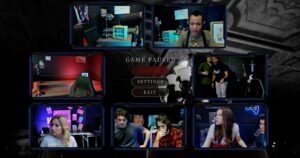
8. Live Upgrade. With only Scott on the screen for any extended length of time, Livescream feels very intimate despite the reach of its horrors. Livescreamers focuses on a multiplayer gaming experience, leaving out the viewer commentary and instead focusing on a group that inhabits the same physical and digital spaces. What new opportunities for character-driven horror alongside conceptual and visceral scares does this shift in focus open? The graphics are much better—do you feel there’s more of a focus on the digital components? Yes or no, what difference do you think the graphical upgrade makes to your storytelling?
MI: Gunner Willis was a powerhouse solo performance in Livescream, and it also utilized some of my novel writing chops to inspire the audience to connect with characters whom you only ever meet in text. But with only a couple main characters at the core of the story, the emotional arcs are pretty simple. A lot of the entertainment of the film then becomes about “spot the homage!”
Even though Livescreamers is a visual facelift, I actually think the game is less of a focus. The first Livescream is very much a love letter to existing horror games. The chat is drowning in easter eggs. We trade a lot of that winking and homaging in Livescreamers for character and drama instead. The games are set pieces filled with tension, but that tension often comes from shining a light on the flaws of the characters or on good old-fashioned scares. Sure, Livescreamers has its share of borrowed mechanics and familiar aesthetics, but it’s not nearly as much of a fandom parade.
As for multi-player, it was a huge opportunity to work with an ensemble of on-screen actors who you can see, you can hear, and who you can actually see die. I’m really proud of my cast for bringing nine very different humans to life, all of whom represent some form of monster that has been created by the gaming and streaming industry. And hey, it’s less reading for the audience, which I think a lot of folks appreciate.
9. Livescream and Livescream Again! Horror sequels generally up the ante for onscreen action and violence as well as, when mystery with potential for deepening lore is involved, greater development of mystery and lore. At one point a character in Livescreamers refers to ongoing events as “al dente creepypasta.” What are the sequel’s attitudes and—vaguely, without spoilers—contributions to the larger lore of the game and its imperiled players? What can viewers expect in terms of upgrades to the horror’s visibility onscreen?
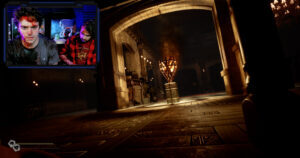
MI: In terms of upgrades, it is hella gorier and more violent than the first one, including emotional violence. While Livescream touched on the horrors of depression, loneliness, and those who seek purpose in a punishing world, Livescreamers goes even deeper in real world horror, touching on sexual harassment, corporate greed, racism, queerphobia, PTSD, and more.
The larger lore wasn’t really going to be explored, because I just hate when tech horror tries to explain itself too hard. Just slows down the whole movie and ruins disbelief when you have some crone whip out an old Bible and say, “the demon Azazel is now targeting cell phones!” or some shit. I actually was told in an early development note to explain the motive of the game more, and while I took that note a bit to expand upon the rules and motives of “the House” and “the Siren,” I refuse to give any sort of explanation as to where this all began and where it came from. I cannot think of an answer that doesn’t amount of “midichlorians.”
Because ultimately, a rigged game that forces characters against each other is just an allegory for capitalism. Even if you “win” the game, there will be consequences waiting just outside the door – a bigger game you cannot win, no matter how ruthless you are to your equals in the gutter. Scott is an example of someone who is trapped in such a game and can’t really win as a solo person, even with best intentions. The characters of Livescreamers show that if you abandon your peers, you’re similarly doomed. The only real way out is teamwork.
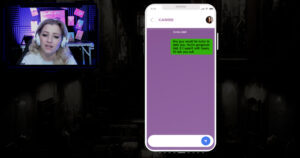
10. Access! How can people learn more about you, view your films, purchase your films, and generally get access to your world (please provide any links you want to share)?
MI: Big things coming to the Octopunk Media channel on YouTube this year (http://youtube.com/octopunkmedia), including the worldwide FREE premiere of Livescream on Saturday 2/10! I am also on Instagram @octopunkmedia, and if you’d like to join our community, you can check out our Discord server https://discordapp.com/invite/evxxwef
About the FilmmakerMichelle Iannantuono is an award-winning writer/director from Charleston, South Carolina. Her previous features include 2018’s Livescream, which was nominated for a Rondo Award and won Best Director at Nightmares Film Festival; 2020’s Detroit Evolution, a queer transformative fan film in the Detroit Become Human video game universe that has surpassed 2 million views on YouTube; and 2023’s Livescreamers, recipient of Best Screenplay at Genreblast and Best Director at NYC Horror Film Festival.
Her previous shorts include “Fame Fatale,” “Seven Deadly Synths,”, and “Detroit Reawakening,” which has half a million views on YouTube. She also produced Michael Smallwood’s “What a Beautiful Wedding,” which screened at FilmQuest, NYC Horror Film Fest, and more.
She is at the helm of Octopunk Media, a media production company with over $25,000 raised for charity to date, a combined 70,000+ worldwide followers, 150+ paying monthly patrons on Patreon, and with fan events hosted in NYC, Munich, Detroit, and London.
The post Interview with Filmmaker Michelle Iannantuono: Livescream and Livescreamers appeared first on L. Andrew Cooper's Horrific Scribblings.
January 31, 2024
Interview with Author Jeff Strand: Demonic, Veiled, It Watches in the Dark (Eek!), and Nightmare in the Backyard (Eek!)
Celebrated author Jeff Strand kindly agreed to answer some questions about his two most recent novels and two more coming soon!
Demonic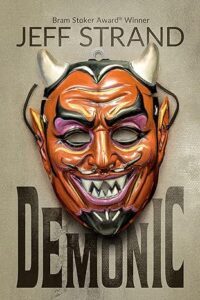 Click the pic for more!
Click the pic for more!From the Bram Stoker Award-winning author of Pressure and Autumn Bleeds into Winter comes a new novel of unrelenting terror.
Corey is falling in love with his co-worker Quinn. This is a problem. Not only because Quinn is married, but because her husband is a serial killer known as the Toledo Trasher, who has been forcing her to participate in his savage crimes.
With nothing but Quinn’s best interests in mind, Corey shows up at their home with a gun in his pocket and a knife in his hand.
Unfortunately, there are some very dark forces at work, and Corey makes Quinn’s situation worse than he could have ever imagined. And now things are about to get really, really bloody…
With his trademark frenetic pacing and pitch-black humor, Demonic is Jeff Strand at his devilish best.
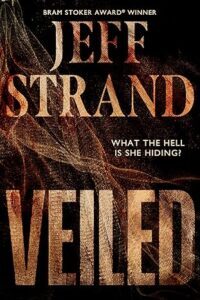
The first time their eyes lock, it’s an amused and sympathetic look from Alice at the next table. She can tell Nate’s blind date is going horribly awry.
The second time is a chance meeting at a grocery store. Or is it by chance? It’s a little weird, but either way, Nate and Alice hit it off immediately.
He really likes her. They have great chemistry. But there’s something a little off—okay, a lot off—about her. Not just the unexplained sadness. It’s an intense desire, almost a desperation, for things to move much faster than Nate is comfortable with.
Alice has an obvious secret. What’s she hiding?
When Nate finds out…well, nobody said this was a romantic comedy…
From the Bram Stoker Award-winning author of My Pretties and Autumn Bleeds into Winter comes… Veiled.
It Watches in the Dark (Eek!)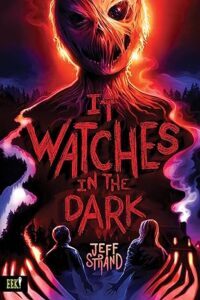 Available April 2, 2024! Pre-order the hardcover now!
Available April 2, 2024! Pre-order the hardcover now!“She glanced over her shoulder. Had the scarecrow moved? It stood there, smile stitched on its face, but now it felt like a smirk.”
Prepare to be scared silly in this creepy middle-grade novel! Twins seek medical help in a remote village after their father is in a canoeing accident… only to discover the scarecrow that stands watch in town may have a stronger hold over the residents than expected. Perfect for fans of R.L. Stine, Dan Poblocki, and Mary Downing Hahn.
Twins Oliver and Trisha love going on adventures with their dad. Canoeing and camping on the Champion River will be their best trip yet! But when they capsize in rapids, their father is knocked unconscious. Alone and without cell phone reception, their only choice is to continue down river for help.
Hours of paddling brings them to an old dock, and a narrow path leads them to a small village. The townspeople are kind and helpful but strangely focused on the giant scarecrow in the village square. “He watches over us,” the twins are told in whispers. “He keeps us safe.”
An old woman warns the twins not to spend the night in the village. Not if they ever want to leave. But with the sun soon to set and their father not well enough to be moved, how can they escape? More importantly, can they survive?
Nightmare in the Backyard (Eek!)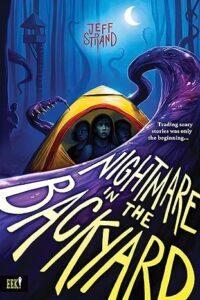 Available August 6, 2024! Pre-order the hardcover now!
Available August 6, 2024! Pre-order the hardcover now!When the scratching starts on the tent, a backyard camping trip turns terrifying for three friends. Prepare to be scared silly in this creepy middle-grade novel for fans of R.L. Stine, Dan Poblocki, and Mary Downing Hahn.
Chloe, Avery, and Madison can’t wait to spend the night camping in the backyard. Smores! Spooky stories! Trading secrets! It’s going to be awesome. Sure, Elijah the kid next door keeps trying to prank them, but it’s all in good fun. Who doesn’t like a little scare after the sun has set and the moonlight casts creepy shadows everywhere?
Then the scratching starts on the tent fabric. The girls think it must be Elijah again, but there’s no one outside. As the scratching gets more insistent, the girls may need to start asking WHAT is making that noise rather than WHO. Can they make it through the night?
The Interview1. Speed Demon. The description of Demonic refers to your “trademark frenetic pacing.” I’m still learning about your trademarks, but Demonic’s breakneck narrative speed is definitely a standout quality: it starts on a roll, gets faster, and never slows down. How do you plan a story so that the action and horror will proceed with nary a pause? How do you manage characterization while the characters can hardly catch their breaths? “Pitch-black humor” is another trademark, and aspects of Demonic are indeed quite funny. Where does the humor come from, and how do humor and pacing relate?
JS: The pacing doesn’t require that much planning ahead, beyond coming up with a concept that will sustain it. I worked out the big turning points of Demonic, and I knew I could tell the story without any padding. I try to maintain a fast pace even in something like Veiled, which is a psychological thriller without a lot of action.
Characterization is always my primary focus. The goal is to create compelling characters very quickly, but also never to lose sight of their personalities when the action kicks in. There’s an extended car chase in Demonic, but it’s Corey and Quinn in the vehicle, not some 1980’s video game characters, and how they’re reacting to the situation is what’s important. Corey has never experienced anything like this. He works a desk job. Corey and Quinn’s relationship is in a very weird place at the moment. That’s all key to the scene, though, obviously, I also want the reader to think “Woooo-eeeeee, that was a kick-ass car chase!”
For me, the humor is usually instinctual. I write humor pretty naturally, so if it’s a novel like Demonic, I’m not thinking, “Okay, I need a good joke here.” (Unlike, say, my novelization of Attack of the Killer Tomatoes, where the whole point was to be funny.) I allow myself quite a bit of creative license, but I do try to keep the humor believable within the context of the story.
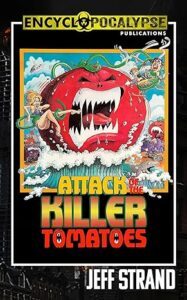
2. Demon Theory. I don’t think I’m spoiling anything by saying that conflicts involving forces one might describe as “demonic” occur in Demonic, but they seem very different from Exorcist-style battles between the forces of Heaven and Hell. How would you describe the demonic in this novel’s universe? What, if any, religious context might it have? What makes this version of the demonic scary?
JS: Without giving too much away, they’re humans who have pledged their loyalty to somebody very bad, and this loyalty comes with certain benefits. There’s not much in the way of religious context—there aren’t any Bible passages quoted in the book. You’re not going to close the book and question your existing worldview. They’re scary because, as our heroes discover early on, they don’t exactly die the way a normal person would.
3. Demon Hunter? Corey, Demonic’s protagonist, fumbles his way into the main plot, and he does a few things that are remarkably heroic yet (forgive me) remarkably stupid. How would you describe Corey, and why did you design your protagonist this way? How sympathetic do you think readers generally feel toward him? Do you feel his character says something about “regular” guys? Why or why not?
JS: Flawed heroes are a recurring theme in my work, and it’s always a tricky balancing act. Unless it’s in something like Bang Up, purely for comedic effect, I don’t want to write about characters who are stupid. Corey isn’t an idiot. He’s just in waaaayyyyy over his head, and not every decision he makes is the best one. My goal is always to show things from the character’s perspective and have the reader think, “Okay, that worked out badly, but I might have done the same thing.”
You’re supposed to be rooting for the guy, and based on the reviews, I think readers do. I assume that most “regular” guys accept that if they were in this kind of mess, they might not handle it like Jack Reacher. I’m an intelligent guy who is extremely savvy about online scams, but not too long ago one of them got me and I clicked a link that subscribed me to several hundred mailing lists. Hopefully that didn’t make me too dumb to live!
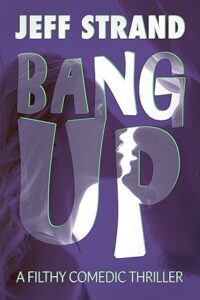
4. Femmes Fatales. Quinn in Demonic and Alice in Veiled both know a lot more than they initially share with their male co-stars and, at least partly through their feminine allure, get the guys involved in overwhelmingly dangerous situations. They’re not noir stereotypes, but they do seem like femmes fatales. Do you see them that way? What might be the consequences of seeing either character through such a lens? Alice’s situation, not revealed until halfway through the book and developing until the end, makes her character particularly problematic, so I’ll repeat what I asked about Corey: how sympathetic do you think readers generally feel toward her?
JS: I don’t really see Quinn that way. She’s not manipulative and wasn’t trying to pull Corey into this situation. She had too much to drink and told him more than she should have, and he took the initiative to try to solve her problem without telling her. He got himself into this mess and made things much worse for her.
Obviously, Alice is difficult to discuss without spoilers, but the question is “How far would you go?” Because much of the plot of Veiled is a closely guarded secret and reviewers have (mostly) been considerate about not blabbing the details, I haven’t received much feedback on that aspect, but I have heard from readers who told me they can relate and would do the same thing. But if a reader hates her, that’s also a valid response, and I don’t think it takes away from the experience!
5. At Home with the Range. Your bio says your novels are “all over the place,” and I get a taste of that moving from Demonic, which focuses on fast action and explicit horror, to Veiled, which focuses on suspense, subtler, grounded horror, and so much mystery that asking questions about it without revealing too much is challenging. How and when do you determine which genre conventions, moods, and styles will govern a project? Do you deliberately change focuses as you move from one project to the next?
JS: Very deliberately. I don’t want to write the same book over and over. When I go really, really dark, as with My Pretties or Bring Her Back, I try to follow it up with something more fun. If my last book was supernatural horror, I might try a thriller. Every once in a while, I’ll do a complete outlier like Kumquat, a romantic comedy. Within the very important context that writing is my only source of income and I have to write stuff that my readers want to buy, I try to mix things up.
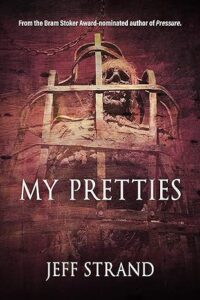
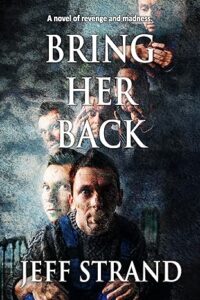
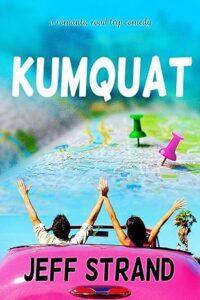
6. Veiled Inspiration? A couple of familiar nightmares seem to lie in Veiled’s foundation. The first, mentioned in the description, is the girlfriend who wants too much commitment too soon. The second—hopefully not too much of a spoiler—is saying something insensitive in the wrong company and having it come back to haunt you. Did first- or second-hand experiences with such nightmares inspire you? Where did (what you can share about) Veiled originate?
JS: Veiled originated with that great big reveal at the halfway point. It wasn’t going to be a secret; it was simply going to be the plot of the book. But when I began to construct the story, I realized that it would be more effective if the reader didn’t know what was happening, and so I reworked it as a mystery.
I haven’t had any experience with girlfriends who want too much commitment too soon, but I also haven’t had any experience with werewolves, so I was able to fake it. As for saying the wrong thing… I’m still haunted by stuff I said thirty years ago to people who probably forgot it thirty seconds later. In my non-fiction book The Writing Life: Reflections, Recollections, and a Lot of Cursing, I wrote about an event where a woman came up to my table to rave about how much she loved Cyclops Road. We talked for a couple of minutes, and then a friend I’d never met in real life came up behind me to introduce herself. My attention was pulled away with a quick “Hey, great to finally meet you!” and when I turned back, the woman was gone, never to be seen again. She probably thought I was a complete douchebag. It makes me sick to think about that moment, but what if she obsessed over it even more…?
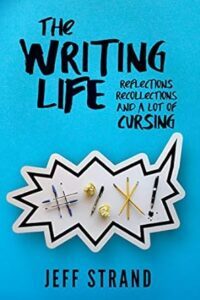
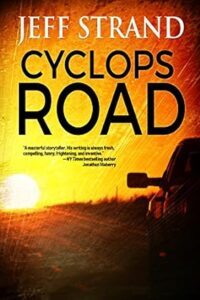
7. Childhood Inspiration. More than once, Corey in Demonic retreats into happy childhood memories of the Scholastic Book Fair to escape the horrors around him. I get the feeling you might have similar memories (I certainly do). Now you write middle-grade novels that might be the stuff of such memories for a new generation. Does enabling those kinds of experiences motivate your middle-grade writing? What inspired you to target younger readers with It Watches in the Dark and Nightmare in the Backyard, both of which are forthcoming later in 2024?
JS: Though I do think “Okay, how would I have reacted to this situation at this age?” there’s almost none of my personal experience in either of these books. I just try to create characters and have them behave in a believable manner. I keep the slang and pop culture references to a bare minimum because that kind of stuff can become hilariously out of date very quickly. The inspiration for writing these came from my editor at Sourcebooks saying, “Hey, you wrote a few YA comedies for us, would you now like to write some middle-grade horror novels?”
The inspiration for the specific books was from my frequent process of asking, “What horror trope haven’t I tackled yet, and how can I twist it around?” In this case it was folk horror and Lovecraftian horror.
8. Eek! Maybe I’m just sensitive to the idea of being trapped overnight in a small village that seems to be controlled by an evil scarecrow, but It Watches in the Dark sounds freaky to me, and I’m a hardcore horrorhound. Is it as scary as it sounds? How do you measure out the fright factor to make the level appropriate for middle grade? How do you feel about giving kids nightmares?
JS: It’s even scarier than it sounds. You definitely can’t handle it. But seriously, it’s really just about walking the line between “fun creepy” and “disturbing creepy.” I want it to live up to the promise of a book that has a great big scarecrow on the cover, but my goal is not for the kids to close the book and stare off blankly, their fragile minds coping with the nihilism of existence. It’s the scariness of a campfire story or a rollercoaster. (Admittedly, my editor did ask me to tone down some bits that went a little too far.) If a kid has to sleep with the lights on for a couple of nights, that’s part of the fun of being a horror fan. There’s no bait and switch–the hope is that a kid who picks up a book with that cover is looking for that kind of reading experience!
9. Backyard Universe. I remember the backyard being a place to build worlds in my imagination, but home was always nearby for a quick escape. In Nightmare in the Backyard, how do you transform the girls’ backyard camping excursion into a universe remote enough for help to seem out of range and the dangers to seem life-threatening?
JS: A big part of their problem in the book is that their cell phones don’t work, and nobody in the neighboring yards can seem to see or hear what is happening. Chloe’s mother is right there inside the house, but she has no idea what’s going on! They aren’t in a cabin deep in the woods, but they might as well be.
10. Maddening. Your bio says several of your books are in development as motion pictures, and you’re MOSTLY not allowed to blab any details. I’m seizing on that “mostly” and asking—what details CAN you share? Which books? Can you say anything about timelines? Are you involved with the screenwriting? Your writing is very visual and could translate well to the screen. Exciting stuff!
JS: There’s a lot of stuff going on, but I’ve found the idea of “Don’t ask how a bad movie got made; ask how anything gets made at all!” to be entirely true. It’s unreal. I’ll just go ahead and bombard you with a list of titles that are in some stage of development: I Have a Bad Feeling About This, Wolf Hunt, Clowns Vs. Spiders, Allison, A Bad Day For Voodoo, Kutter, The Greatest Zombie Movie Ever, Kumquat, An Apocalypse of Our Own, and The Odds. For some of these I wrote the screenplay; for most I didn’t. Some have been in the works for several years. One is a big-studio production that earned me my WGA card for writing the script. None of them have yet involved somebody turning on a camera to record a moving image.
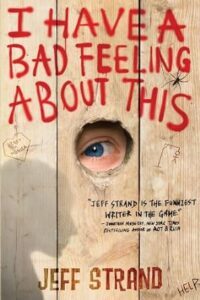
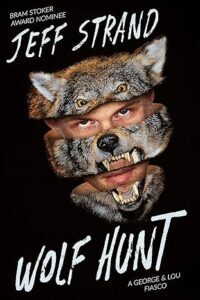
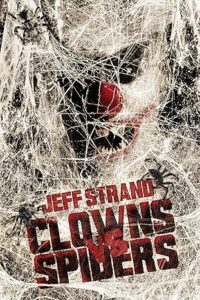
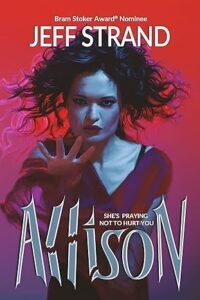
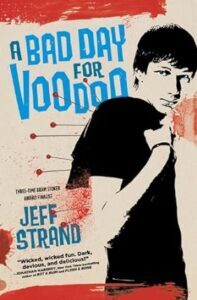
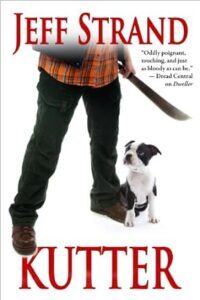
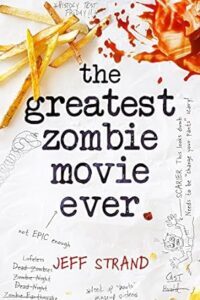
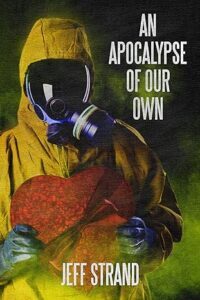
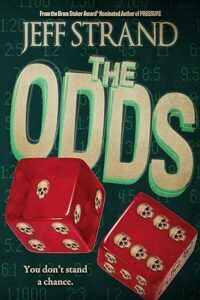 About the Author
About the Author
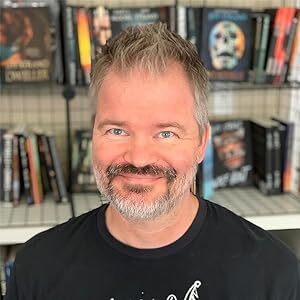
Jeff Strand’s bio was funnier when he talked about losing the Bram Stoker Award four times, but he’s now a Bram Stoker Award WINNER!
His novels are usually classified as horror, but they’re really all over the place, almost always with a great big dose of humor. He’s written five young adult novels that all fall into the “really goofy comedy” category.
Several of his books are in development as motion pictures, and he’s mostly not allowed to blab any details, which he finds MADDENING.
He currently lives in sunny, warm Duluth, Minnesota.
The post Interview with Author Jeff Strand: Demonic, Veiled, It Watches in the Dark (Eek!), and Nightmare in the Backyard (Eek!) appeared first on L. Andrew Cooper's Horrific Scribblings.
Interview with Author Jeff Strand: Demonic, Veiled, It Watches in the Dark (Eek!), and Nightmare in the Back Yard (Eek!)
Celebrated author Jeff Strand kindly agreed to answer some questions about his two most recent novels and two more coming soon!
Demonic Click the pic for more!
Click the pic for more!From the Bram Stoker Award-winning author of Pressure and Autumn Bleeds into Winter comes a new novel of unrelenting terror.
Corey is falling in love with his co-worker Quinn. This is a problem. Not only because Quinn is married, but because her husband is a serial killer known as the Toledo Trasher, who has been forcing her to participate in his savage crimes.
With nothing but Quinn’s best interests in mind, Corey shows up at their home with a gun in his pocket and a knife in his hand.
Unfortunately, there are some very dark forces at work, and Corey makes Quinn’s situation worse than he could have ever imagined. And now things are about to get really, really bloody…
With his trademark frenetic pacing and pitch-black humor, Demonic is Jeff Strand at his devilish best.

The first time their eyes lock, it’s an amused and sympathetic look from Alice at the next table. She can tell Nate’s blind date is going horribly awry.
The second time is a chance meeting at a grocery store. Or is it by chance? It’s a little weird, but either way, Nate and Alice hit it off immediately.
He really likes her. They have great chemistry. But there’s something a little off—okay, a lot off—about her. Not just the unexplained sadness. It’s an intense desire, almost a desperation, for things to move much faster than Nate is comfortable with.
Alice has an obvious secret. What’s she hiding?
When Nate finds out…well, nobody said this was a romantic comedy…
From the Bram Stoker Award-winning author of My Pretties and Autumn Bleeds into Winter comes… Veiled.
It Watches in the Dark (Eek!) Available April 2, 2024! Pre-order the hardcover now!
Available April 2, 2024! Pre-order the hardcover now!“She glanced over her shoulder. Had the scarecrow moved? It stood there, smile stitched on its face, but now it felt like a smirk.”
Prepare to be scared silly in this creepy middle-grade novel! Twins seek medical help in a remote village after their father is in a canoeing accident… only to discover the scarecrow that stands watch in town may have a stronger hold over the residents than expected. Perfect for fans of R.L. Stine, Dan Poblocki, and Mary Downing Hahn.
Twins Oliver and Trisha love going on adventures with their dad. Canoeing and camping on the Champion River will be their best trip yet! But when they capsize in rapids, their father is knocked unconscious. Alone and without cell phone reception, their only choice is to continue down river for help.
Hours of paddling brings them to an old dock, and a narrow path leads them to a small village. The townspeople are kind and helpful but strangely focused on the giant scarecrow in the village square. “He watches over us,” the twins are told in whispers. “He keeps us safe.”
An old woman warns the twins not to spend the night in the village. Not if they ever want to leave. But with the sun soon to set and their father not well enough to be moved, how can they escape? More importantly, can they survive?
Nightmare in the Backyard (Eek!) Available August 6, 2024! Pre-order the hardcover now!
Available August 6, 2024! Pre-order the hardcover now!When the scratching starts on the tent, a backyard camping trip turns terrifying for three friends. Prepare to be scared silly in this creepy middle-grade novel for fans of R.L. Stine, Dan Poblocki, and Mary Downing Hahn.
Chloe, Avery, and Madison can’t wait to spend the night camping in the backyard. Smores! Spooky stories! Trading secrets! It’s going to be awesome. Sure, Elijah the kid next door keeps trying to prank them, but it’s all in good fun. Who doesn’t like a little scare after the sun has set and the moonlight casts creepy shadows everywhere?
Then the scratching starts on the tent fabric. The girls think it must be Elijah again, but there’s no one outside. As the scratching gets more insistent, the girls may need to start asking WHAT is making that noise rather than WHO. Can they make it through the night?
The Interview1. Speed Demon. The description of Demonic refers to your “trademark frenetic pacing.” I’m still learning about your trademarks, but Demonic’s breakneck narrative speed is definitely a standout quality: it starts on a roll, gets faster, and never slows down. How do you plan a story so that the action and horror will proceed with nary a pause? How do you manage characterization while the characters can hardly catch their breaths? “Pitch-black humor” is another trademark, and aspects of Demonic are indeed quite funny. Where does the humor come from, and how do humor and pacing relate?
JS: The pacing doesn’t require that much planning ahead, beyond coming up with a concept that will sustain it. I worked out the big turning points of Demonic, and I knew I could tell the story without any padding. I try to maintain a fast pace even in something like Veiled, which is a psychological thriller without a lot of action.
Characterization is always my primary focus. The goal is to create compelling characters very quickly, but also never to lose sight of their personalities when the action kicks in. There’s an extended car chase in Demonic, but it’s Corey and Quinn in the vehicle, not some 1980’s video game characters, and how they’re reacting to the situation is what’s important. Corey has never experienced anything like this. He works a desk job. Corey and Quinn’s relationship is in a very weird place at the moment. That’s all key to the scene, though, obviously, I also want the reader to think “Woooo-eeeeee, that was a kick-ass car chase!”
For me, the humor is usually instinctual. I write humor pretty naturally, so if it’s a novel like Demonic, I’m not thinking, “Okay, I need a good joke here.” (Unlike, say, my novelization of Attack of the Killer Tomatoes, where the whole point was to be funny.) I allow myself quite a bit of creative license, but I do try to keep the humor believable within the context of the story.

2. Demon Theory. I don’t think I’m spoiling anything by saying that conflicts involving forces one might describe as “demonic” occur in Demonic, but they seem very different from Exorcist-style battles between the forces of Heaven and Hell. How would you describe the demonic in this novel’s universe? What, if any, religious context might it have? What makes this version of the demonic scary?
JS: Without giving too much away, they’re humans who have pledged their loyalty to somebody very bad, and this loyalty comes with certain benefits. There’s not much in the way of religious context—there aren’t any Bible passages quoted in the book. You’re not going to close the book and question your existing worldview. They’re scary because, as our heroes discover early on, they don’t exactly die the way a normal person would.
3. Demon Hunter? Corey, Demonic’s protagonist, fumbles his way into the main plot, and he does a few things that are remarkably heroic yet (forgive me) remarkably stupid. How would you describe Corey, and why did you design your protagonist this way? How sympathetic do you think readers generally feel toward him? Do you feel his character says something about “regular” guys? Why or why not?
JS: Flawed heroes are a recurring theme in my work, and it’s always a tricky balancing act. Unless it’s in something like Bang Up, purely for comedic effect, I don’t want to write about characters who are stupid. Corey isn’t an idiot. He’s just in waaaayyyyy over his head, and not every decision he makes is the best one. My goal is always to show things from the character’s perspective and have the reader think, “Okay, that worked out badly, but I might have done the same thing.”
You’re supposed to be rooting for the guy, and based on the reviews, I think readers do. I assume that most “regular” guys accept that if they were in this kind of mess, they might not handle it like Jack Reacher. I’m an intelligent guy who is extremely savvy about online scams, but not too long ago one of them got me and I clicked a link that subscribed me to several hundred mailing lists. Hopefully that didn’t make me too dumb to live!

4. Femmes Fatales. Quinn in Demonic and Alice in Veiled both know a lot more than they initially share with their male co-stars and, at least partly through their feminine allure, get the guys involved in overwhelmingly dangerous situations. They’re not noir stereotypes, but they do seem like femmes fatales. Do you see them that way? What might be the consequences of seeing either character through such a lens? Alice’s situation, not revealed until halfway through the book and developing until the end, makes her character particularly problematic, so I’ll repeat what I asked about Corey: how sympathetic do you think readers generally feel toward her?
JS: I don’t really see Quinn that way. She’s not manipulative and wasn’t trying to pull Corey into this situation. She had too much to drink and told him more than she should have, and he took the initiative to try to solve her problem without telling her. He got himself into this mess and made things much worse for her.
Obviously, Alice is difficult to discuss without spoilers, but the question is “How far would you go?” Because much of the plot of Veiled is a closely guarded secret and reviewers have (mostly) been considerate about not blabbing the details, I haven’t received much feedback on that aspect, but I have heard from readers who told me they can relate and would do the same thing. But if a reader hates her, that’s also a valid response, and I don’t think it takes away from the experience!
5. At Home with the Range. Your bio says your novels are “all over the place,” and I get a taste of that moving from Demonic, which focuses on fast action and explicit horror, to Veiled, which focuses on suspense, subtler, grounded horror, and so much mystery that asking questions about it without revealing too much is challenging. How and when do you determine which genre conventions, moods, and styles will govern a project? Do you deliberately change focuses as you move from one project to the next?
JS: Very deliberately. I don’t want to write the same book over and over. When I go really, really dark, as with My Pretties or Bring Her Back, I try to follow it up with something more fun. If my last book was supernatural horror, I might try a thriller. Every once in a while, I’ll do a complete outlier like Kumquat, a romantic comedy. Within the very important context that writing is my only source of income and I have to write stuff that my readers want to buy, I try to mix things up.



6. Veiled Inspiration? A couple of familiar nightmares seem to lie in Veiled’s foundation. The first, mentioned in the description, is the girlfriend who wants too much commitment too soon. The second—hopefully not too much of a spoiler—is saying something insensitive in the wrong company and having it come back to haunt you. Did first- or second-hand experiences with such nightmares inspire you? Where did (what you can share about) Veiled originate?
JS: Veiled originated with that great big reveal at the halfway point. It wasn’t going to be a secret; it was simply going to be the plot of the book. But when I began to construct the story, I realized that it would be more effective if the reader didn’t know what was happening, and so I reworked it as a mystery.
I haven’t had any experience with girlfriends who want too much commitment too soon, but I also haven’t had any experience with werewolves, so I was able to fake it. As for saying the wrong thing… I’m still haunted by stuff I said thirty years ago to people who probably forgot it thirty seconds later. In my non-fiction book The Writing Life: Reflections, Recollections, and a Lot of Cursing, I wrote about an event where a woman came up to my table to rave about how much she loved Cyclops Road. We talked for a couple of minutes, and then a friend I’d never met in real life came up behind me to introduce herself. My attention was pulled away with a quick “Hey, great to finally meet you!” and when I turned back, the woman was gone, never to be seen again. She probably thought I was a complete douchebag. It makes me sick to think about that moment, but what if she obsessed over it even more…?


7. Childhood Inspiration. More than once, Corey in Demonic retreats into happy childhood memories of the Scholastic Book Fair to escape the horrors around him. I get the feeling you might have similar memories (I certainly do). Now you write middle-grade novels that might be the stuff of such memories for a new generation. Does enabling those kinds of experiences motivate your middle-grade writing? What inspired you to target younger readers with It Watches in the Dark and Nightmare in the Backyard, both of which are forthcoming later in 2024?
JS: Though I do think “Okay, how would I have reacted to this situation at this age?” there’s almost none of my personal experience in either of these books. I just try to create characters and have them behave in a believable manner. I keep the slang and pop culture references to a bare minimum because that kind of stuff can become hilariously out of date very quickly. The inspiration for writing these came from my editor at Sourcebooks saying, “Hey, you wrote a few YA comedies for us, would you now like to write some middle-grade horror novels?”
The inspiration for the specific books was from my frequent process of asking, “What horror trope haven’t I tackled yet, and how can I twist it around?” In this case it was folk horror and Lovecraftian horror.
8. Eek! Maybe I’m just sensitive to the idea of being trapped overnight in a small village that seems to be controlled by an evil scarecrow, but It Watches in the Dark sounds freaky to me, and I’m a hardcore horrorhound. Is it as scary as it sounds? How do you measure out the fright factor to make the level appropriate for middle grade? How do you feel about giving kids nightmares?
JS: It’s even scarier than it sounds. You definitely can’t handle it. But seriously, it’s really just about walking the line between “fun creepy” and “disturbing creepy.” I want it to live up to the promise of a book that has a great big scarecrow on the cover, but my goal is not for the kids to close the book and stare off blankly, their fragile minds coping with the nihilism of existence. It’s the scariness of a campfire story or a rollercoaster. (Admittedly, my editor did ask me to tone down some bits that went a little too far.) If a kid has to sleep with the lights on for a couple of nights, that’s part of the fun of being a horror fan. There’s no bait and switch–the hope is that a kid who picks up a book with that cover is looking for that kind of reading experience!
9. Backyard Universe. I remember the backyard being a place to build worlds in my imagination, but home was always nearby for a quick escape. In Nightmare in the Backyard, how do you transform the girls’ backyard camping excursion into a universe remote enough for help to seem out of range and the dangers to seem life-threatening?
JS: A big part of their problem in the book is that their cell phones don’t work, and nobody in the neighboring yards can seem to see or hear what is happening. Chloe’s mother is right there inside the house, but she has no idea what’s going on! They aren’t in a cabin deep in the woods, but they might as well be.
10. Maddening. Your bio says several of your books are in development as motion pictures, and you’re MOSTLY not allowed to blab any details. I’m seizing on that “mostly” and asking—what details CAN you share? Which books? Can you say anything about timelines? Are you involved with the screenwriting? Your writing is very visual and could translate well to the screen. Exciting stuff!
JS: There’s a lot of stuff going on, but I’ve found the idea of “Don’t ask how a bad movie got made; ask how anything gets made at all!” to be entirely true. It’s unreal. I’ll just go ahead and bombard you with a list of titles that are in some stage of development: I Have a Bad Feeling About This, Wolf Hunt, Clowns Vs. Spiders, Allison, A Bad Day For Voodoo, Kutter, The Greatest Zombie Movie Ever, Kumquat, An Apocalypse of Our Own, and The Odds. For some of these I wrote the screenplay; for most I didn’t. Some have been in the works for several years. One is a big-studio production that earned me my WGA card for writing the script. None of them have yet involved somebody turning on a camera to record a moving image.








 About the Author
About the Author

Jeff Strand’s bio was funnier when he talked about losing the Bram Stoker Award four times, but he’s now a Bram Stoker Award WINNER!
His novels are usually classified as horror, but they’re really all over the place, almost always with a great big dose of humor. He’s written five young adult novels that all fall into the “really goofy comedy” category.
Several of his books are in development as motion pictures, and he’s mostly not allowed to blab any details, which he finds MADDENING.
He currently lives in sunny, warm Duluth, Minnesota.
The post Interview with Author Jeff Strand: Demonic, Veiled, It Watches in the Dark (Eek!), and Nightmare in the Back Yard (Eek!) appeared first on L. Andrew Cooper's Horrific Scribblings.
January 24, 2024
Interview with Author Ryan Harding: Transcendental Mutilation
Hardcore horror writer and pioneer of body horror in print Ryan Harding is here to discuss his new collection of short stories, Transcendental Mutilation, a collection of tales interconnected on several levels.
Transcendental Mutilation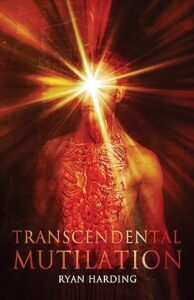 Click the pic for more!
Click the pic for more!SIGILS INCISED, A COMMUNION WITH THE BLADE. A trio of young people stranded on an uncharted island discovers its sickening secrets. A man contracts a degenerative disease through a webcam encounter. An office worker follows the object of his affection into a mysterious club where life, death, and anatomy have no limits. A reforming necrophiliac struggles to maintain the illusion of normalcy in a new relationship. A woman awakens with other captives in the basement of a madman using them to attract impossible prey.
UNLOCK THE GATES OF FLESH, WORLDS WITHIN FLAYED. A decade after the infamous Genital Grinder, Ryan Harding returns with ten more stories, collected for the first time— including the Splatterpunk Award-winning tales “The Seacretor” and “Angelbait”— which plunder the depths of depravity and obsession, yielding offenses and transformations of the flesh never before seen or carved. His first solo work in years dissects its themes and characters alike in a sublime autopsy worthy of the hardcore horror pantheon. Even the vomitorium has its philosophy, and the keys to revelation are all serrated.
EVERY JOURNEY BEGINS WITH A SINGLE SLICE… TRANSCENDENTAL MUTILATION
The Interview1. Transcendental Details. In your “Prelude to Repulsion” at the beginning of Transcendental Mutilation, you mention that stories in the book link to each other as well as to your other works, and indeed, references to Sarah Putnam, Geisha Hammond, the Woodsman, and Agent Orange recur, places such as Morgan, Sandalwood, and Iona come up repeatedly, and the character Kendall appears more than once. Tell us more about your interconnected universe (or, if it’s a multiverse, your multiverse). Which details tend to reappear and why? What do they add to the stories and to readers’ experiences? Without giving too much away, what elements from Transcendental Mutilation might readers expect to see again?
RH: This is something I started in Genital Grinder. That interconnectedness resonated with me in a collection like Bret Easton Ellis’s The Informers. It adds another layer, turning it into its own world with a recurring cast, hopefully investing readers that much more in what’s going on. As stories like “Final Indications” (in GG) and “Last Time at Thanksgiving” (in Transcendental Mutilation) threaten something more apocalyptic, I suppose they function more like resets, although there are recurring threads from GG in TM, and characters and ideas from TM could also manifest in other stories or books one day. The Woodsman is something I’ve thought about revisiting, for instance, and I keep threatening to continue the misadventures of Von and Greg from GG.
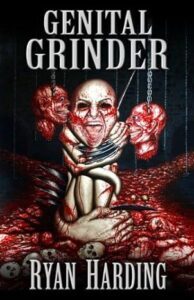
2. Transitory Bodies. Aside from his involvement in the plot of “Orificially Compromised,” who is “Dr. Braedon Obrist,” and what is “Transitory Bodies?” Why have you added a quotation from this work to each tale? Do the quotations point toward a larger, coherent philosophy behind Transcendental Mutilation? If so, would you please—in brief—explain the core of that philosophy?
RH: Dr. Braedon Obrist is sort of like TM’s answer to Brian O’Blivion from Videodrome—a philosopher for a world influenced by technology in ways both physical and metaphysical. You only get so much insight into his views in “Orifically Compromised,” so I thought it would be interesting to use excerpts from his Transitory Bodies book as epigraphs. I imagine TB to be a collection of essays where he explores existential questions proposed by the changing nature of our psyches with technology and the imminent threat of InterphaZ. I just sat down one day and wrote them all, and I liked how they came out. The excerpts obliquely lay out themes for each story. If there is a coherent philosophy, it is the idea that the modern world is altering us in ways we haven’t seen before, connecting us more but also enhancing our individual alienation. We’re patient zeros of a technological and resulting metaphysical virus. The characters in TM are often transformed by that virus or willing to alter themselves, sometimes as an escape, other times as an assimilation. In stories where technology fails, there tends to be something older and darker lurking.
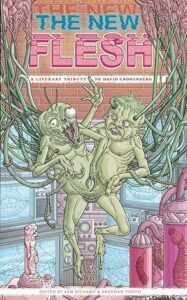
3. Long Live…. “InterphaZ,” mentioned in several stories, especially “Orificially Compromised,” seems right at home with David Cronenberg’s Videodrome and eXistenZ, and since you contributed “Orificially Compromised” to the collection The New Flesh: A Literary Tribute to David Cronenberg, I’m guessing that’s no coincidence (you also praise Cronenberg extensively in your postscript to Transcendental Mutilation). What is InterphaZ, and how specifically does it relate to or reflect on Cronenberg’s creations? More broadly, how have Cronenberg and other filmmakers influenced your writing? What, if anything, is cinematic about your style?
RH: InterphaZ is a mega corporation furthering technology and the subtle (and not so subtle) mutation of its customers. I think it’s a more cynical interpretation of some of the organizations from Cronenberg’s films, slowly recreating the world in its preferred image. In “Orificially Compromised,” doctors must be approved for any treatment pertaining to an InterphaZ product. That only seems barely absurd these days. They also play a role in mind control technology in a novella I wrote called The Profile, part of the Call Me Hoop anthology. I love David Cronenberg, and his body horror films had a major impact on me. It’s something we all have to confront if we live long enough. Our bodies will change and ultimately fail us. It’s a more visceral metaphor for the dying process. I believe graphic horror is especially the province of horror films, where gore in splatter movies like Dawn of the Dead preceded the works of Clive Barker and the Splatterpunks in the 80s. Extreme horror is often like elaborate special FX work, e.g., the exploding head in Scanners, the transformations in Videodrome, The Thing, etc., and the carnage of Italian horror like Fulci, Argento, etc.I try to be as descriptive as I can with those sequences, although ideally they will feel more like something readers are experiencing than merely witnessing.
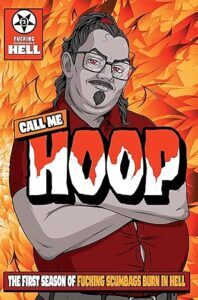
4. Genital Mutilation. The title of your previous collection, Genital Grinder, seems to warn of this motif: you write about violent damage to or transformation of genitalia in quite a few tales in Transcendental Mutilation. What’s your attraction to this region of repulsion? What do you think attracts readers to genital chaos (I squirmed but couldn’t stop reading)? Except when characters enjoy it (and they usually don’t), do you see genital mutilations as punishments for wayward desires? Why or why not?
RH: That was something tabooer when I began writing my hardcore stories. I mentioned how splatter was prevalent in horror movies, but anything genital related was scarce compared to eviscerations or head explosions. I would say disembowelment was the ultimate splatter effect (anything involving genitals was quick to hit the cutting room floor to avoid an X rating), but the rarity and intimacy of a scene like the castration in Make Them Die Slowly could make an indelible impression, too. In 1999, I read Edward Lee and John Pelan’s Shifters, which includes this excruciating moment with a woman and a pizza cutter. I planned to read at the Gross-Out contest at World Horror Con, and that book (as well as some of the other hardcore epics of the day by Edward Lee) awakened me to just how far I would have to go to really stand out. You couldn’t just use splatter horror for a template—you had to go beyond what even movies would show. That was much of the impetus, particularly in trying to create that feeling of shock some of us felt watching a movie like Make Them Die Slowly or Joe D’Amato’s Buried Alive on video back in the day. Something that went far beyond the Freddy and Jason fare that had lapsed into greatly diminishing returns. Since even mainstream horror goes so much farther now, it’s harder to conjure the feeling of witnessing something you weren’t meant to, like those Euro horror atrocities in the video age or the imagery and lyrics of the Chris Barnes era of Cannibal Corpse. Do I see that genital violence as a punishment? That element is sometimes there, but not always. Sometimes it’s just the random cruelty of fate. It’s also a part of you that is usually hidden from the world, so there’s an added element of violation to it, as well as the awareness of how sensitive those areas are.
5. Mutilation Pro Quo. Along lines similar to the last question, some of the violence in your stories seems rooted in payback, particularly payback for men who have sexually objectified or harassed women. Even though in the postscript you say you’re “not big on moralizing,” is cosmic justice ever at work? Do you see yourself indulging a feminist—or at least anti-misogynist—streak? Why or why not? How do you think your own treatments of gender relations compare with gender relations in hardcore horror more generally?
RH: It is a little funny to get a question like that, because after Genital Grinder, many would swear I must be an avowed woman hater. I feel like there was equal opportunity eradication in that collection, but there are prevalent misogynistic attitudes in it for sure, since some of the stories are about killers, and I was influenced by reading a lot of true crime back then. I wasn’t trying to redress a balance in Transcendental Mutilation, so much as just exploring the consciousness of the kind of person who would be amenable to revenge porn (“Threesome”) or online indecent exposure (“Junk”). I see these stories in particular as part of the EC Comics end of the spectrum, where somebody receives an ironic comeuppance, so I suppose that’s a sort of cosmic justice at play. As for my treatments of gender relations, though, like you alluded, I try to avoid moralizing. I don’t want to come off as didactic. I’m trying to present everything as part of a story, not a sermon. I don’t know that it’s necessarily a hardcore horror staple to go the other way with it, but it seems like a broader tendency in books and film in general now, to their detriment. I want my work to stand apart from that.
6. Transcendental (Sub)genres. While most of the tales have what we might fairly call supernatural components, some come closer to more familiar supernatural subgenres, such as tales interested in the modern mythic, (sub)urban and internet lore—“Down There” and “Junk,” perhaps “Threesome”—and stories of the occult/religious—“Angelbait” and “Temple of Amduscias.” Did you set out to write out in these subgenres, or did you follow your muse and end up there? How do you feel about these categories and this sort of categorization?
RH: “Down There” just sort of happened. I owed a story to Matt Shaw’s Masters of Horror anthology, and there was a news item about the girls in Michigan who stabbed another friend as a sacrifice to the Slender Man. I started thinking about how ominous the woods seemed when I was a kid, riding past them on the school bus, and how eerie the woods still seem. I started from that fear and “Down There” just revealed itself to me day after day. That doesn’t often happen for me with short stories. I usually have to know where they’re going in advance, or they don’t go anywhere. With “Angelbait,” I was reading about some of the sickening things saints had purportedly done, and how an angel was said to have appeared at one martyrdom. I thought, “What if that was someone’s goal?” Everything fell into place with that. “Temple” was intended for a King Diamond tribute anthology. Jarod Barbee of Death’s Head Press reiterated to me that he wanted something a lot more reliant on atmosphere, so I needed a place that was quiet and isolated. A lot of King Diamond/Mercyful Fate music has occult themes, too, which was another important element, although what unlocked that story for me finally was just figuring out Olivia, the protagonist.
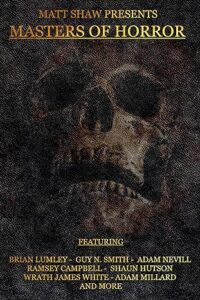
7. Mutilation for Heavenly Purposes. Speaking of “Angelbait,” it is one of the two Splatterpunk Award winners in this collection, and it’s powerful, reminding me of two of my favorite filmic works of extreme horror, John Carpenter’s Cigarette Burns (from the anthology TV series Masters of Horror) and Pascal Laugier’s Martyrs (one of my favorite films of all time). Be as vague as you need to be to avoid spoilers: is what this story says about the nature of transcendence, however good or bad, a view of transcendence you mean to profess? Why or why not? Do you think that perhaps, over the years, horror has transitioned from asking “Why is there evil in the world?” to asking “Does good even exist?” Why or why not?
RH: I loved Martyrs, too! I think it’s the rare kind of movie able to resurrect that old feeling of shock over what you are seeing, with a lingering aftermath of disturbance. I’m sure I had it in mind writing “Angelbait,” and maybe subconsciously Cigarette Burns, too. I think a good summary of it thematically is a Satyricon lyric: “Damned or saved, how could we ever know?” In the world of this story, being chosen is a curse, and divine intervention comes with its own horror. Likewise, I think transcendence elsewhere in the collection (“Divine Red”) is something positive, however deranged. In “Orificially Compromised,” it’s more ambiguous… how much of Porter’s euphoria is even his own at the end? Transcendental Mutilation to me means the willingness to ascend above the inherent banality of existence, with characters willing to mutilate their lives, themselves, and/or others in pursuit of whatever higher meaning they aspire to. That’s an interesting question about horror and the existence of good. There does seem to be more cynicism now. Even someone like David Lynch who clearly believes in diametrically opposed good and evil can really drag you through the dark. Perhaps there is this decaying belief in everything—government, media, law, religion, etc., and it manifests in more creative expressions of hopelessness and pessimism.
8. Transcendental (Sub)genres II. In this collection’s other Splatterpunk Award winner, “The Seacretor,” I think what I like best is what I see as transformations among genres, unified by horror: first a shipwreck scenario following Robinson Crusoe (which you tag), which segues into sci-fi, which segues into weird tale. Did you know you would be taking such turns when you first drafted, or were you pantsing it? What do you think the different genre elements contribute to the atmosphere, character development, and impact of the story? Why tree-fucking?
RH: A year or two before I wrote “The Seacretor,” I was watching a movie set on an island, and I started thinking about what I would write with that kind of setting. I came up with the final reveal rather quickly. I also had an older idea about someone crash-landing on a strange planet and becoming “fixated” by a tree, and it made sense to transplant that idea into what became “The Seacretor.” A tree just made sense as something that would be in that landscape, and I came up with what I thought was the most unexpected effect it could have on the characters. I remembered the idea when I owed Jack Bantry a story for Splatterpunk Forever. I didn’t have the group dynamic figured out beforehand, but as soon as I started writing it in first person, it all came together. I had a couple of Stephen King stories in mind—“Beachworld” from Night Shift and “Survival Type” from Skeleton Crew. I think there’s something really potent about a scenario where characters are stranded, because you’re immediately thinking about what you would do in that situation. How long could you do the sensible things before desperation drove you to something you wouldn’t have ever considered a few days before? And what if your only options ended up transforming you? There’s a contrast I like in the story about the beauty of the scenery with the loneliness of Ben, the protagonist, who may be losing Tanya to an annoying rival. In stories without a technological backdrop, I like the conflict to be born of something primal or ancient, and who knows how many strange aeons that island has been there?
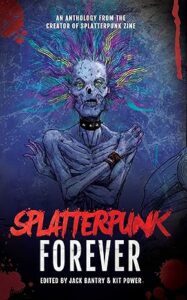
9. Transcendent Transgression. Barring child pornography, can you imagine a story that would go too far to write? If so, what would it involve? If not, why not?
RH: I have found myself thinking certain scenes might be going too far sometimes. There is one in The Night Stockers where I knew some people were likely to quit reading then and there. There’s one in The Profile, too, where I thought maybe it was too much. But I also felt good about both those scenes, that they turned out well and had the effects I wanted. I even read the latter at KillerCon last year, and people laughed in all the right places. The wanton violations and mutilations of Von and Greg were perhaps viewed differently in 2012 when Genital Grinder was published than they would be now, but I think that’s probably also the appeal for readers just discovering GG… some stories may seem even more hardcore now than what I wrote them in 1999-2002 or so. I feel like a book with Von and Greg in such a different social climate is a bigger challenge now. I have to do it, though, one of these days. What would such a story look like? Our luckless duo will be attending college in this scenario. Anyone familiar with them can see why that would be such a disaster, with all the collateral damage of gender relations and generational and class differences, among others. Something with all the wrongness and hilarity of Edward Lee’s Header 2 that remains true to the respective personalities of our beloved degenerates, such as they are.
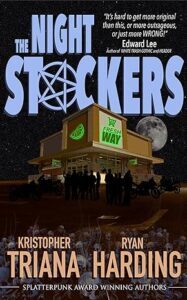
10. Access! How can readers learn more about you and your works (please provide any links you want to share)?
RH: I have a Linktree here: https://linktr.ee/necroaf?utm_source=linktree_admin_share..
That covers a lot of ground, but I’ll also go ahead and throw in my Amazon page here: https://www.amazon.com/stores/Ryan-Harding/author/B01N1HSDZ5
And Facebook: https://www.facebook.com/ryanhardmorbid
Thank you for this interview and the insightful questions!
About the AuthorRyan Harding is the four-time Splatterpunk Award-winning author of books such as Transcendental Mutilation, Genital Grinder and collaborations with Jason Taverner (the Agent Orange slasher novels Reincarange and Reincursion), Kristopher Triana (The Night Stockers), Lucas Mangum (Pandemonium), and Edward Lee (Header 3). He contributed the novella The Profile to the anthology Call Me Hoop, and his short stories have appeared in anthologies such as Brewtality, The Distended Table, The Big Book of Blasphemy, The New Flesh: A Literary Tribute to David Cronenberg, Splatterpunk Forever, Past Indiscretions, Into Painfreak, and The Year’s Best Hardcore Horror Vol. 3. His work has also been published in German, Italian, and Polish. Upcoming projects include a novel with Bryan Smith and the third book in the Agent Orange series.
The post Interview with Author Ryan Harding: Transcendental Mutilation appeared first on L. Andrew Cooper's Horrific Scribblings.
January 17, 2024
Interview with Author Christine Morgan: Trench Mouth, The Infernal Series, The Night Silver River Run Red, and More
Award-winning, extreme, and diabolically clever horror author Christine Morgan is here to discuss some books you can get your filthy hands on now and a few more coming monstrously soon.
Trench Mouth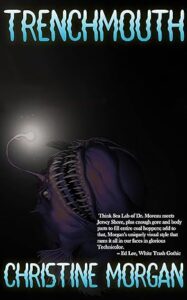 Click the pic for more!
Click the pic for more!Fathom Five … a state-of-the-art oceanic research facility, suspended far below the surface. There, in the dark and the deep, a team of top-notch scientists studies the ecosystems and denizens of an aquatic environment as alien as another planet.
There, they also conduct illicit experiments upon hapless human subjects, with the goal of giving our species a chance to adapt to a changing world. Or, at the very least, to create mutant freaky fish-people, because, why not?
Oh, the arrogance and hubris of genius! Oh, the freaky things that already dwell in the strange, hostile depths! In the cold, crushing, silent pressure of a blackness lit only by eerie bioluminescence. Things that don’t take kindly to intruders. Things that are ancient, and enormous, and hungry.
Things like … TRENCH MOUTH.
“Think Sea Lab of Dr. Moreau meets Jersey Shore, plus enough gore and body parts to fill entire coal hoppers; add to that, Morgan’s uniquely visual style that rams it all in our faces in glorious Technicolor.”
—Edward Lee, author of White Trash Gothic
“This is exactly the kind of book I love. Supersonic pacing. Blood spilled on every page. A grisly weird-science techno-thriller set in the crushing stygian darkness, Morgan’s Trench Mouth lures you in and leaves you gasping.”
—Lee Murray, three-time Bram Stoker nominee and author of Into the Mist
Lakehouse Infernal
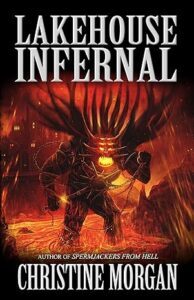
“Lakehouse Infernal is the coolest, ball-bustingest, most outrageous, and most ENTERTAINING horror novel you’re likely to find in a long time.” – Edward Lee, author of City Infernal
Lake Misquamicus was an unremarkable lake in Florida, unremarkable that is until suddenly it was filled with six billion gallons of blood, bile, pus, piss, shit and …things… directly from the pits of Hell. First the public was in shock, then the government built a wall, and as time passed it became another urban legend. But for some, it has become a travel destination. Spring-breakers, drug-runners, and religious nuts. But a weekend getaway on the shores of Hell may not be the safest idea…
With an introduction by and officially endorsed by splatterpunk legend Edward Lee, Lakehouse Infernal is an official entree in Lee’s infamous Infernal series. Christine Morgan (Spermjackers from Hell) expands on this universe with her own twist on hardcore horror tourism.
“Think Spring Break, only instead of a beach house, it’s a lakehouse, but the lakehouse IS IN FUCKIN’ HELL, that’s right, a chunk of Hell that’s been upheaved and pushed up into our pretty little world—sunny Florida, no less!” – Edward Lee
Warlock Infernal
6 6 6
Six minutes into the unholy consummation, someone finally thought to cut the live feed … but the momentous events were only just getting underway! As the Hell-Centurion Favius claims his kingdom and queen, as the Wall rises and the Dome descends, the survivors trapped inside will face some critical decisions.
Six hours ago, Gregory Nachtwald was holding hands with an angel … and how can anybody go back to any sort of normal life after that? Especially as a newly-awakened warlock with a dark and mysterious family legacy, possessing powers he hardly understands?
Six days later, they went for the nuclear option… a disgruntled and betrayed nation, and a terrified world, preparing to unleash their ultimate weapon against the diabolical stronghold that had once been a remote Florida lake.
Welcome back to Lake Misquamicus for another smutty, gory, depravity-laden adventure in Warlock Infernal, sequel to the Splatterpunk Award winning Lakehouse Infernal!
The Night Silver River Run Red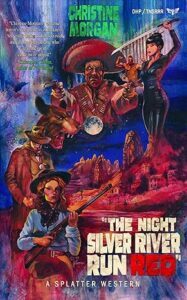
Some things, according to Cody McCall, are worth risking a whipping. Such as sneaking out with your friends after dark for a peek at the traveling show setting up just outside of town. Oddities, the signs promise. Marvels. Grotesqueries. Exotic attractions and mysterious magics. Not as if they’d be allowed to attend otherwise, not with parents and preacher and schoolmarm all disapproving. But how often does a chance like this come along? There isn’t much else by way of excitement in quiet, peaceful Silver River, a once-prosperous boom town slowly gone bust. Worth risking a whipping, sure. Worth risking life and limb, and maybe more? Worth risking being ripped to pieces by ravenous, inhuman brutes? Worth crossing paths with those strange, silent cult-folk from the high valley? Worth all the fire and bloodshed and horror and death? Because something far worse than any ordinary traveling show has come to town, and one thing is for certain: those who survive, if any, will never forget the night Silver River run red.
The Interview1. Self-Reflective Splatter. At least some of your stories overtly position themselves in relation to other stories and to genre tropes. In Spermjackers from Hell, for example, characters often compare their creepy situations to setups for horror movies and their escalating danger to levels of video games, and the description of your recent limited-edition release Homebody mentions that the premise about inheriting a house in the middle of nowhere “sounds like the start to at least a hundred different horror movies.” What does this self-consciousness add to your narratives? Do you think of yourself as writing… dread the word… postmodern horror? Why or why not?
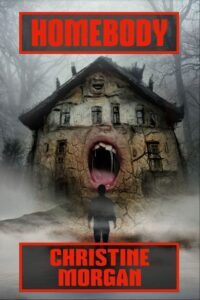
CM: Egads, I wouldn’t even know where to begin or how to describe categorizing something as “postmodern” or not. Labels like that seem so constricting. I just like to write what’s fun for me to write, and let it fall where it may. The only time I even think about genre beforehand is when it’s for a themed call that requires/requests it (as in, “cosmic” or “body horror” or whatnot).
Otherwise, I rarely consider categorizing; I was most of the way done with the first draft of Homebody before it even occurred to me I might actually be writing a bizarro book… and I’ve been told by experts that Spermjackers could also be considered, to quote one of those experts, “bizarro as fuck.” As for the tropes, pop culture references, movies and video games, etc… same thing; I do it because it’s fun for me. Whether that means the works won’t hold up so well over time or become dated, then so be it. I mean, in the forthcoming Nympho Shark Fuck Frenzy (co-written with Susan Snyder), we’ve got a bit where a grieving mother slaps a marine biologist during a live televised press conference, and one character turns to another and says something like, “Dude, your mom just went all Will Smith on the fish lady.”
I also think movies and comics and video games are our modern mythology and cultural lore, so dropping in a reference to LOTR or Star Trek or the MCU isn’t much different from writers of olde dropping in references to classical Greek or Roman myth. I feel the same way about memes; it fascinates me to be alive in the time of memes, watching them develop and become their own form of language. That you can say something like “ain’t nobody got time fo dat” or “this is fine” and people instantly grasp the larger context, I think that’s amazing and cool. Anything that helps a reader be better able to connect with a story or character, and relate on a personal level, is, for me, what it’s all about.
2. Sadism Under the Sea. Trench Mouth involves several threats that contribute to the carnage, including the scientists experimenting on human subjects in the name of progress or because, as the book’s description says, “Why not?” This flippant attitude is funny, but given the historical reality of experiments on human subjects, it’s also a disturbing depiction of human monstrosity. Assuming it does, how does this horror/sci-fi dimension of your novel engage with historical realities? How do your human monsters compare to—and/or measure up against—your featured creatures?
CM: Oh, we humans are, by far and always, the worst monsters. We’re the ones with the capacity for cruelty and evil, the ones who find excuses for or bald-faced made-up reasons to abuse or neglect others. We’re selfish in a way that goes far beyond simple self-preservation. We’re divisive and petty and pretty damn awful. I’m a longtime student (amateur anyway) of history and anthropology, and some of the stuff we’ve gotten up to over the millennia… dang. Yes, we’ve also accomplished a lot of incredible and positive things, but often at the expense of a lot of suffering. And sometimes, it comes down to a matter of whether to laugh, scream, rage, or cry. Given those options, I tend to err on the side of laugh, of finding the absurdity and showcasing it, of shouting to the world “look how goddamn STUPID this is!” in hopes people might notice and catch themselves. I know other authors who take different tacks… Wrath James White comes to mind; not for nothing is that his name, because his legitimate anger at bullshit injustices comes through SO very clearly in his work, it about reaches off the page to grab you.
Animals, meanwhile? They, for the most part, don’t do all that. When they’re presented as the ‘monsters’ in creature features, nine times out of ten it’s just animals doing what animals do, to survive, on instinct, not out of any particular malice or deliberate sadism. We may monsterize them for it because it makes us feel better–we go into their territory, fuck with their environment, and have the sheer gall to call them monsters for fighting back or defending themselves or simply trying to eat and survive? The phrase “shark-infested waters” … that’s where they LIVE, ffs; we’re the ones who are intruding. People talk about cats being cruel, toying with their prey, and maybe some of it’s true, but they’re also practicing necessary skills; they’re not going out of their way to be raw sadists, the way people might. (certain exceptions may apply … the smarter the animal, the more capacity for humanlike malice … lookin’ at YOU, dolphins …)
So. yeah, in Trench Mouth, there’s the giant squid and the anglerfish and the denizens of the deep, and they ARE threats, oh yes, but they’re far from the monsters. Dr. Margot Yale, sociopath that she is? She and her team, and their cavalier attitudes, are where the real villainy is.
3. Technicolor Trenches. You have a very immediate visual style that Edward Lee describes as feeling like “glorious Technicolor.” How do you construct your images and keep the surfeit of splatter from becoming repetitive? To tantalize our readers, would you mind providing a couple of colorful examples of your visual imagery from Trench Mouth (maybe some gore, maybe a glimpse of a creature)?
CM: Descriptive language is my favorite part of the whole process. One of the reasons I so love writing Viking stories is that you can get away with outrageously over the top purple prose, because that’s the way their sagas were told! Similar for cosmic/Lovecraftian, and extreme/splatter … you can go overboard, go nuts, and it fits. In my more splattery stuff, I also tend to go for the funny/absurd, to make it vivid and memorable. In my western, The Night Silver River Run Red, I have a lot of that … the kids slopping around in the bloody remnants of a massacre in a cabin, a woman blasting an outlaw into strawberry jam with a shotgun, etc. Serious, yes, but also silly.
Here’s an excerpt from Trench Mouth, from a scene I still feel horribly guilty about … the whole time I was writing it, I was all “wtf are you doing with this Land Before Time shit?” … in which a couple of orphaned little deep-sea critters join up against all odds and, well, chomp …
A light shines through the deep darkness. It beckons.
Curious, they swim toward it. Together, mismatched brothers from other mothers, they have no fear.
It is marvelous, this light. It is beautiful, entrancing. A luminous globe of wonder like nothing they’ve ever seen.
They don’t even notice the monstrous underbite extending beneath them, stretching and expanding, unfolding rising rows of translucent teeth. They don’t notice the cavernous maw widening and widening.
With a single violent convulsion, the immense jaws snap shut. A huge shadow churns the black water. As the marvelous glow glides sedately away, the last of its illumination lingers on nothing but the drifting tip of a flipper and part of a fin.
4. Infernal Tourists. The idea that sparks Lakehouse Infernal—a lake overwhelmed by filth from Hell becomes a travel destination—seems to cast a satirical eye on tourism and the sites and sights that draw people. Is satire part of your agenda? Going a step further, if visiting Lake Misquamicus shows questionable judgment, what does the book say about the “hardcore horror tourism” involved in reading hardcore horror? If Hell existed, and it opened its Gates to visitors, what percentage of your readers might buy tickets? (For the record, I’m not saying I wouldn’t get in line… depends on the price.)
CM: I would totally want to visit Lake Misquamicus, and when the adjacent little townlet calling itself Area 666 was doing a thriving business in Hell-themed tourism, I would’ve been all over that. But then, despite having watched every single movie multiple times and knowing full well the problems, I still would’ve bought an annual pass to Jurassic World and gone there as often as I could. Yet, at the same time, when I was working residential psych and discovered the house I was doing a solo overnight shift in had a dark spooky basement I hadn’t known existed, I shut and re-locked the door and was NOT about to go down there to investigate. Funny how our minds work. Those memes people post about how they’d probably die trying to pet something they shouldn’t, or their last words would be like “here kitty kitty” … that’s me… but the insurance commercial with the mannequin tea party in the attic and the guy nopes right the hell out? That’d also be me.
All that said, Edward Lee’s version of Hell, The Mephistopolis, is my all-time favorite setting ever; he did THE most spectacular job combining aspects of multiple theologies and mythologies, yet he did it in a way both horrific and absurd… it resonated with me on every level. Would I want to GO there? Well… okay maybe, but under conditions; I certainly would hope for a better fate than the average damned soul… if I could be a demon or warlock or something, or do a brief sight-seeing tour… but I also know how ridiculously squeamish I am in real life, so… hard to say.
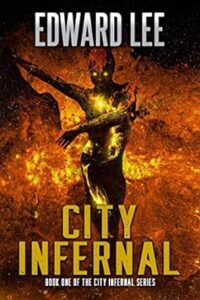
5. Infernal Kudos. If I count correctly, you’ve been nominated for Splatterpunk Awards eight times (and the Awards have only been going since 2018!). You won for Lakehouse Infernal. For those less familiar with splatterpunk and extreme/hardcore horror, would you please explain how a book featuring “six billion gallons of blood, bile, pus, piss, shit and …things… directly from the pits of Hell” wins an award? My recent reading experiences (and interviews) with the likes of Monica J. O’Rourke and Wrath James White tell me that standard splatterpunk provides a deluge of gore, but really good splatterpunk provides more. You’re really good. What’s the award-winning “more” of Lakehouse Infernal?
CM: … wait what eight times? Jeebus krispies; stats like that make me want to hide under the bed and breathe into a paper bag for a while; I usually don’t follow the numbers or stress about rankings; I see too many other authors eating themselves alive over such things, while here I am still perpetually surprised and gratified anybody at all (who doesn’t HAVE to for some reason) might be reading something I wrote.
I could hardly believe it when Lakehouse won; KillerCon was virtual that year and all I remember is totally freaking out and babbling like a lunatic and crying my fool head off during the ceremony. It happened during a really difficult time of my life (she said, like her life’s been a piece of cake since?) and just felt like SUCH validation for the struggles I’d been going through. And yes, I do think it’s because of more than the gore; I think the humor and the sarcasm and the commentary, not to mention the Lee cameo and homages, made it something extra.
That ‘something extra’ is what puts the punk in splatterpunk, giving it a twist or an edge, being a little bit smartass or wry, differentiating it from more straightforward extreme horror or gore. As with pornography, or bizarro, it strikes me as one of those things that’s hard to define, but you know it when you see it. Feel it. Intuitively.
6. Infernal Sequel. Did Lakehouse Infernal’s success spawn the sequel, or did you already have another book for that universe in mind? And as sequels go, Warlock Infernal seems to take one of the “rules” deeply to heart, ratcheting up the stakes with bigger potential for world-changing horrors. Does the scope of the sequel affect the pacing, mood, and/or tone? Why or why not? How will readers feel about this book in relation to its predecessor?
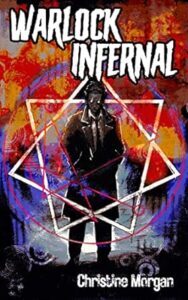
CM: I have an ingrained tendency to write leaving things open for a continuation of the story; for this, I blame/credit years of running roleplaying games, when you always had to have the next adventure waiting in the wings and plant seeds for the characters to follow up on. In writing books, this has been both a blessing and a curse, because I have a whole list now of books I want to do sequels for. And, oh, better believe it, I knew even as I was writing Lakehouse that it’d want more. The characters insisted. They weren’t done yet; there was still a lot to play with and expand upon, and I was delighted to be able to do it. With, yes, higher stakes … now that we’d gotten to know these characters, develop feelings good or bad for them, set bigger events in motion … with the first book having served to set the stage and established the background … the second book could splay out and go wild.
I think, hope, and believe readers enjoy Warlock as much as or even more than Lakehouse; I’ve gotten feedback on some of the relationships and developments to suggest as much — Favius and June, for instance; a reader described them as one of horror’s “greatest romances,” which quite frankly is messed up on multiple levels and makes me deliriously happy. Writing them, in particular, was SO much fun; I especially loved it when Favius had to get his Hell-inspired rhetoric on and give speeches. They really did deserve each other!
7. Infernal Partnerships. Speaking of the Infernal universe, your books are entries in the series that began with Edward Lee’s City Infernal. Lee’s approval probably helps, or at least started helping after you finished your first entry, but how did (and do) you feel about playing in somebody else’s sandbox for your Infernal creations? You and Lee at least got along well enough to partner for the recent novella Cunt-Kick the Witch Bitch. What did each of you bring to that collaboration? What did you take away?
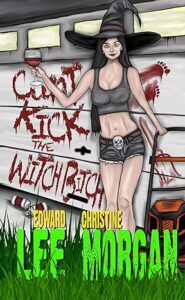
CM: Being not just allowed but enthusiastically welcomed to play with Lee’s toys has been THE greatest thing. It came about because I’d made a character in an MMORPG who was a 1930’s era gumshoe whose backstory involved being killed by a demoness and ending up in the Mephistopolis, which let me combine the whole noir detective dialogue with the Infernal setting. Matt Brimstone, P.I. I wrote him into a story, then asked Lee’s permission to submit it to an anthology call … after reading it, he agreed … and that opened the door (Matt has since also appeared in a novella called “Damned Lazy,” and is always a hugely fun character to write.
I also come from, and I admit this freely, a LONG history of writing fanfiction, mashups, and pastiches, so, the prospect was hardly new to me. I was quite accustomed by then to settings not my own creation, with their own rules to abide by (or find clever ways to break and get around). A lot of writers sneer at or shit on fanfiction, but I always found it an invaluable way to practice my craft. If I’m writing my own world and my own characters and I get it wrong, nobody necessarily knows it but me. If I’m writing Gargoyles fanfic and I screw up Xanatos or Goliath? PLENTY of people will be RIGHT THERE ready and willing to tell me so in no uncertain terms!
So, for me, being able to adapt and assimilate and follow Lee’s style was something I already felt confident and comfortable in doing. To actually take it a step further into true collaboration was at the top of my wish list. And then, one day out of the blue, he emailed me about an idea he’d been tinkering with, sent me a file of notes and partial manuscript, and invited me to see what I could do with it. Turned out, what I could do was grab it and run and go wild, so that what he’d probably originally thought would be a short story, by the time we got done back-and-forthing it, bloomed into something much bigger. I’d do it again in a heartbeat!
8. Western Run Red. We’ve already touched a bit on the horror/sci-fi blend in Trench Mouth, a blend still innovative but rooted in a tradition at least as old as Mary Shelley’s Frankenstein (1818). In The Night Silver River Run Red, you go for a horror/Western blend, which is less familiar (I’d at least risk saying it goes back to Cormac McCarthy’s Blood Meridian, 1985) but established enough for Amazon’s tag on your title, “Splatter Western,” to make sense. What drew you to the Western? What makes horror fit with Western elements in your book? What fun directions did the Western’s genre conventions let you take in terms of character, setting, and style? Would you write another Western? Why or why not?
CM: Westerns, like Viking stories, appeal to me because they require their own inherent language and style and feel to ring true, and sometimes bring stuff to the party you might not be able to get away with in more mainstream settings. I’d written a few weirdish Western short stories before, and my pioneer-blizzard-snow-monsters novel White Death is probably close enough to count, but the prospect of tackling something packed with and playing with those classic tropes was too alluring to even try to resist. It doesn’t hurt that I grew up in the desert southwest, with a history nut for a dad, who would take us to Calico or Bodie as often as we’d let him.
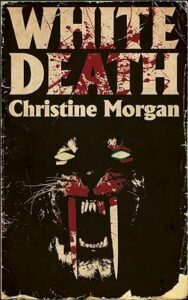
As for writing another, well, earlier I mentioned that list of sequels … there are definitely plans in the works to continue what I started in Silver River. At the moment, I’m thinking a series of novellas or novelettes, following up with the surviving townsfolk, the Truthers, the carnies, etc. And, of course, I simply MUST write one titled “Horsecock Rides Again.” So, those will likely happen in the next couple years.
9. Inverted Tourism. The Night Silver River Run Red also draws on another horror tradition, the traveling show (cf. Tod Browning’s classic film Freaks, 1932, Ray Bradbury’s classic novel Something Wicked This Way Comes, 1962, or Richard Laymon’s newer classic The Traveling Vampire Show, 2000). How would you describe your book’s relationship with this tradition? The traveling show potentially offers the inverse of the tourism you put on display in Lakehouse Infernal: instead of people going to the horrors, the horrors come to the people. How does this inverted relationship between horror and home affect your characters’ reactions and the development of the story in The Night Silver River Run Red?
CM: I got SUCH a kick out of writing the carnies! That trope of travelers and entertainers can fit into just about any genre; we’ll always have need for distraction and diversion, going back as long as humans have had settled civilizations. I fully expect there’ll be traveling shows between distant star colonies or across the apocalyptic wasteland. And it provides the perfect haven for weirdos and outcasts, the strange, the exotic, people who might otherwise never fit in or have a true home.
What I’m hoping to do in the follow-up stories–a collection tentatively titled “Oddico’s Oddities” for now–is delve into the backgrounds of the individual characters, to see how they came to be and how they ended up on the road. Some of the details, I already know (like the origin of The Living Ghost, whose story will begin with the line “My parents died before I was born”) while others remain as much a mystery to me as anyone else.
10. Another Sequel from Hell. Without giving too much away, I think I can safely say that your novel Spermjackers from Hell concludes with a look at events that will unfold after the end of the story’s main action. In our correspondence, you mentioned that you’re now working on a sequel to Spermjackers. Is the original’s conclusion a preview of the sequel, or are you going in a different direction? What can you reveal at this point about the scenario, the characters and, of course, the buckets of blood and cum?
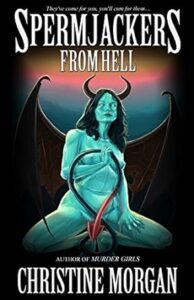
CM: I am indeed working on the sequel right now, which will be called Babydaddies of the Damned and picks up right where Spermjackers left off. While the focus in the first book was mostly on the male characters, the guys who did the initial summoning and the other men in town beset by resultant succubus-summoning activities, the second book shifts gears as the next phase of the process begins. To wit: succubus sperm-gatherers converting to incubus sperm-deliverers, making sneaky nocturnal visits to the women in town.
The women in town who, as it happens, well, let’s just say there was an accident at a fertility clinic, involving the disposal of some highly potent drugs into the local water system, so pretty much anyone capable of ovulating is ovulating like crazy. While it’s THEIR turn to have steamy sex-dreams, and being … ‘injected,’ for want of a better word … with demonically-enhanced semen. Going for the whole Midwich Cuckoos / Village of the Damned thing (hence the title).
The primary character in BDD is Beth, the tough-chick friend of the guys who had the bright idea to summon a demon in the first place. Only, now, they’re all missing, and she’s the only one who has any reason to suspect what’s really going on in town, and she has to try to find a way to stop it, or at least to keep herself safe.
About the Author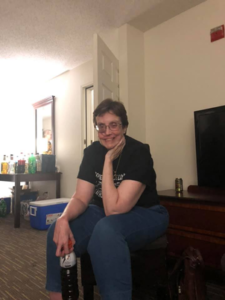
Christine Morgan divides her writing time among many genres, from horror to historical, from superheroes to smut, anything in between and combinations thereof. She’s a future crazy-cat-lady and a longtime gamer who enjoys British television, cheesy action/disaster movies, cooking, and crafts. Which latter two led the Bizzong! podcast to refer to her as “The Martha Stewart of extreme horror,” so make of that what you will!
She is the author of multiple novels, including the Splatterpunk Award Winning Lakehouse Infernal. Her short stories have appeared in dozens of anthologies, as well as several collections. An active member of the extreme horror and bizarro communities, she also reviews and takes on the occasional editing/proofreading gig.
The past few years have seen her through many life-upheavals, including leaving her 30-year residential psych career, moving out of state, serving as her mother’s full-time caregiver, and attempting to manage a tangled mess of family estate and probate. She’s currently hiding out in the high desert with her quirky recluse father, waiting to see what happens next.
She is always glad to hear from readers, as well as other authors (and hey, agents, publishers, movie people, it’s all good!)
The post Interview with Author Christine Morgan: Trench Mouth, The Infernal Series, The Night Silver River Run Red, and More appeared first on L. Andrew Cooper's Horrific Scribblings.
December 27, 2023
Interview with Filmmaker Michael J. Epstein: The Once and Future Smash
Michael J. Epstein, the thoughtful, witty, and always provocative filmmaker behind darkly amusing films such as TEN, Blood of the Tribades, and Clickbait, is here to discuss his latest twist on the horror genre, mockumentary The Once and Future Smash.
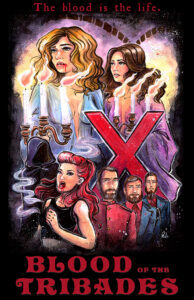 Click for the trailer, the film, and more!
Click for the trailer, the film, and more!
 Click to visit Michael’s website!
Click to visit Michael’s website!
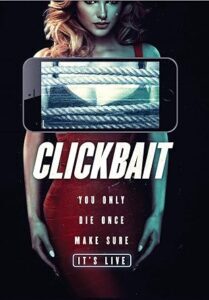 Click for the trailer, links to the film, and more!
The Once and Future Smash
Click for the trailer, links to the film, and more!
The Once and Future Smash
In 1970, Mikey and William both portrayed football cannibal Smash-Mouth in the influential cult hit End Zone 2. Now, 50 years later, only one can wear the mask.
The Once and Future Smash is the story of Mikey Smash and William Mouth, who both played Smash-Mouth, the football-themed slasher character in the lost 1970 cult film End Zone 2. They are now on the convention circuit 50 years later, trying to reclaim the iconic role in the upcoming reboot sequel that starts one hour into End Zone 2.
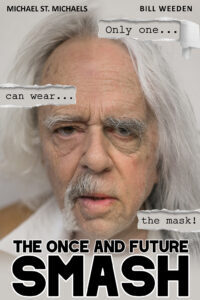 Click for a trailer and more!
Click for a trailer and more!A Launch Over and Without Your Head Film; Produced by: Sophia Cacciola / Michael J. Epstein / Neal Jones
Directed by Sophia Cacciola / Michael J. Epstein – Written by Michael J. Epstein
Starring: Michael St. Michaels (The Greasy Strangler), Bill Weeden (Sgt. Kabukiman N.Y.P.D.), A.J. Cutler
Featuring: Mark Patton (Nightmare on Elm Street 2), Laurene Landon (Maniac Cop), Richard Elfman (Forbidden Zone), Mark Torgl (Toxic Avenger), Melanie Kinnaman (Friday the 13th Part V: A New Beginning), V.C. DuPree (Friday the 13th Part VIII: Jason Takes Manhattan), Victor Miller (Friday the 13th), Marc Sheffler (Last House on the Left), Carl Solomon (Tropical Cop Tales), Adam Marcus (Jason Goes to Hell), Todd Farmer (Jason X), John Dugan (Texas Chain Saw Massacre), Bill Johnson (Texas Chainsaw Massacre 2), Bob Elmore (Texas Chainsaw Massacre 2), Lloyd Kaufman (Troma), Claudio Fragasso/Rossella Drudi (Troll 2), Tim Dry (Xtro)
The Interview1) Ends of Influence. You actually shot the majority of End Zone 2, the film at the heart of your mockumentary The Once and Future Smash. The fictional production year for End Zone 2 (noted at the film’s beginning), 1969, has me a little stumped. While I can see influences from 60s films by the likes of H.G. Lewis and Mario Bava, as a proto-slasher—even one that supposedly influenced Wes Craven, Tobe Hooper, and John Carpenter—End Zone 2 feels like it might have come from a bit later. Why did you choose 1969? Also, the film feels like it might have been spawned from the Tarantino/Rodriguez collaboration Grindhouse (2007), distressed restoration and all. To what extent did Grindhouse, along with the renewed interest in cult horror it spawned, influence your project? Are you working from a perspective of genuine nostalgia, or do you have a more critical distance?
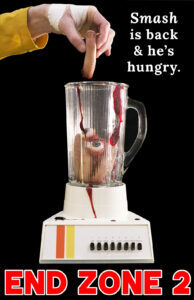 Click and scroll down for an End Zone 2 trailer and more!
Click and scroll down for an End Zone 2 trailer and more!MJE: End Zone 2 was conceived on the intriguing idea that an obscure, previously unknown movie sparked the horror genre’s explosive growth in the 1970s and 1980s. This concept positions the film ahead of its time rather than conforming to the era’s typical style. In producing it, we were mindful to emulate that period’s shooting techniques and technological constraints.
It’s hard to say what goes on in the subconscious, and we certainly enjoyed Grindhouse, but I don’t think Grindhouse was an influence. I would say that we came to it from an almost opposite direction. Our inspiration emerged more from the culture surrounding conventions, the resurgence of interest in forgotten films, and the recognition of overlooked actors. The Once and Future Smash was our initial idea, leading us to craft a film-within-a-film that adhered to specific criteria. Our motivation stemmed not so much from nostalgia but from a fascination with how nostalgia has shaped a culture of rediscovery and celebration.
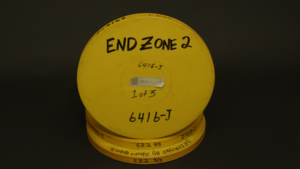
Although our film incorporates satirical elements, its core intention is to honor the allure of nostalgia and the commemoration of past performers and films rather than to satirize them. I find great joy in watching actors reengage with the convention circuit and return to acting, even though I’m not particularly interested in collecting autographs.
2) Influence 2. Maybe I’m led on by the involvement of Claudio Fragasso and Rossella Drudi, but I see a relationship between your film(s) and the films Troll 2 (1990) and Best Worst Movie (2009), the latter being a documentary about the cult following that grew up around the reputedly terrible former, a horror film (sort of). How far do you think this relationship goes? How do you feel about treating films as “camp,” as—to paraphrase Susan Sontag—especially good because they’re awful?
MJE: The concept behind Troll 2 / Best Worst Movie is similar to our approach, but I don’t think it was the primary influence. While not initially intentional, I later recognized that The Once and Future Smash might have been structurally influenced by the documentary Life After Flash. Experiencing Life After Flash and Flash Gordon back-to-back at a festival opened my eyes to a specific layered approach to storytelling. I aspired to recreate a similar experience in our film. Life After Flash intriguingly juxtaposes the grandeur of Flash Gordon with the more humble, somewhat melancholic present-day life of Sam Jones. In Smash, we aimed to parallel this by intertwining the narrative of the End Zone series with the personal stories of Mikey and William.
 Mikey and William’s stories collide..
Mikey and William’s stories collide..My appreciation for “camp” films is inherent, yet I’m not fond of deliberately creating “bad” films. I believe in approaching filmmaking with sincerity and genuine effort. A film’s merit doesn’t stem from its flaws but from its ability to entertain or provoke thought. Even films with technical shortcomings can be great if they are engaging or thought-provoking. Labeling an entertaining film as “bad” seems dismissive to me. For instance, I find Troll 2 entertaining, whereas The Room simply doesn’t resonate. In Best Worst Movie, director Fragasso attempts to explore this concept, but perhaps the language barrier hindered the full expression of his ideas. Having Fragasso and Drudi participate in our film was exciting, as I admire their unique and captivating work without a caveat of irony. Night Killer stands out as my favorite among their creations.
3) Unconventional Conventionists. A major setting of The Once and Future Smash is “Mad Monster Party,” a horror convention. I think you and I might have first met at a similar convention. What is your film’s view of such conventions and their attendees? Do you expect the culture you (perhaps lovingly) mock to embrace this film? Why or why not?
MJE: Our film is undeniably a tribute to convention culture, embracing its unique quirks and humor. While we poke fun at certain aspects of this culture, our intention is always in good spirits. This approach resonates well with convention culture fans, who have shown a great appreciation for our movies. Their understanding and enjoyment of our work is exactly what we aimed for, and seeing that connection is gratifying.
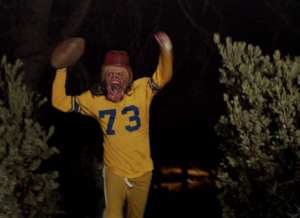 Smash-Mouth from End Zone 2, a horror icon for convention attendees
Smash-Mouth from End Zone 2, a horror icon for convention attendeesThe comparisons drawn between our film and the works of Christopher Guest are incredibly flattering. While we may not quite reach the lofty standards set by Guest’s films, we’re proud to have aspired to such excellence. Just as metal enthusiasts relate to Spinal Tap, theater aficionados to Waiting for Guffman, and folk music fans to A Mighty Wind, we wanted to create a space where horror and convention enthusiasts could see a playful reflection of their passions. Our aim with Smash was to provide a fun, satirical, yet affectionate mirror for these fans to enjoy and relate to, celebrating the unique world they love so much.
4) The Ten Yard Line. Your earlier feature TEN (2014) also seems to play a bit in giallo/slasher territory (while acknowledging Agatha Christie, whose And Then There Were None, 1939, is arguably a slasher prototype in prose). What’s your attraction to this type of film?
MJE: We realized early on that End Zone 2 is somewhat of a revisit of our work in TEN. We try to make a completely different movie each time we dig into a feature, but somehow, we landed back at that style. It was kind of the necessary story to tell within the story here, so our direction felt necessary and somewhat predestined.
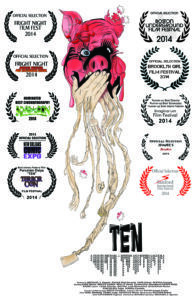 Click for a trailer, links to the film, and more!
Click for a trailer, links to the film, and more!That said, I am glad you mentioned the idea of proto-slashers. One of my many pet peeves is the journalistic or analytical idea that slashers started with Halloween. Thirteen Women from 1932 has a group of women being murdered one by one as revenge for the mistreatment of one of their sorority sisters, and as they die, the killer crosses out their photos in the yearbook. There aren’t graphic, on-screen kills, but otherwise, you’re looking at a standard 80s slasher. There are probably films preceding that with heavy slasher elements.
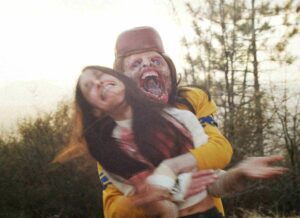 A shot from End Zone 2 that might anticipate Tobe Hooper
A shot from End Zone 2 that might anticipate Tobe HooperThis historical perspective presented a unique challenge for End Zone 2. We aimed to position it as the genre’s pioneering, most influential film, even setting it in 1970. However, as you noted, many elements in our film seem to draw from later works. If we delve deeper into film history, we’d likely find earlier movies that encompass nearly all the aspects we included in End Zone 2. This realization underscores the complexity and depth of the genre’s evolution, something we hoped to honor and play with in our film.
5) Keeping the Ball Moving. A pending sequel/reboot for the End Zone series is central to the story of The Once and Future Smash. What is the film’s attitude toward the reboot phenomenon? If there’s any difference, what is your own attitude? Older stars in your film are scrambling to get on board with the reboot, and they risk incredible awkwardness—as do many stars at conventions who cling to the glory of films decades from the past. In my experience, such stars tend to have a pretty good sense of humor about convention appearances. Is continuing to live for such glory ultimately more endearing or amusing? Perhaps both—or something else entirely?
MJE: We do pretty heavily mock the requel concept where films are made that ignore some arbitrary number of other sequels and resume the story at some seemingly random spot. Still, ultimately, I am fine with people making whatever movies make sense for them to make. I do not like the newer Halloween series, and I thought the most recent Texas Chain Saw requel was not good, but I dig Halloween H20 and Texas Chainsaw 3D.
The film’s perspective doesn’t extend beyond the humorous notion we developed: not only disregarding sequels, but ignoring part of the original film that the new sequel is based on. I found the idea of abruptly halting a movie midway and dismissing the rest quite amusing. This concept also significantly influenced the plot of Smash, focusing on the lost segment of the film and the resulting incomplete version of End Zone 2.

Witnessing the resurgence of interest in stars from past movies is truly heartwarming. It’s wonderful to see these actors recognized and appreciated, realizing their impact on audiences. This resurgence is one of the most remarkable phenomena I’ve witnessed in the entertainment industry. It struck a personal chord when I attended a packed midnight screening of a 4K restoration of Pieces. This was a film I had once rented on VHS, thinking only a handful of people knew about it. Years later, it’s meticulously restored, drawing full houses in movie theaters. This contrasts sharply with the fact that several Best Picture winners aren’t even available on Blu-ray, let alone capable of selling out screenings. This experience gave me a new perspective on what films truly resonate with people. Seeing the actors from these films embrace their legacy and celebrate with fans is incredibly gratifying and a testament to the enduring power of cult cinema.
6) Real Stars, Mock Movie. Speaking of stars, the list of people involved in The Once and Future Smash (see “Featuring” under the film’s description, above) is like a who’s who of actors and other filmmakers on the horror film convention circuit. How did you get so many great people involved? Can you share any stories about working with them? What were their reactions to the nature of your project?
MJE: The genesis of our film can be traced back to a pivotal conversation with our producer, Neal Jones. Neal, known for his “Without Your Head” podcast and extensive experience interviewing horror icons, was instrumental in bringing the project to life. After I shared the concept with him, Neal leveraged his connections to gain access to Mad Monster and agreed to join as a producer. His primary role involved reaching out to his network of former guests and friends, inviting them to participate.
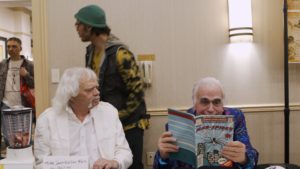 Mikey and William vie for glory at a convention more than 50 years after their “star” turns in End Zone 2
Mikey and William vie for glory at a convention more than 50 years after their “star” turns in End Zone 2When writing the script, I didn’t know who would ultimately join the cast, so I used placeholders like “Melanie Kinnaman type” for the characters. We worked with Neal to compile a list of potential candidates we believed would fit the film well. To my surprise, many of them agreed to be part of it, largely due to their trust in Neal and trust via his reputation that the project wouldn’t portray them in a negative or ridiculous light.
While Neal arranged most of the interviews, geographical constraints meant we often conducted them without him. We provided some context to the participants, but largely, they placed their trust in us. The script included specific references and jokes about each individual’s films or careers. We made it clear that they could opt out of anything they weren’t comfortable with. Still, almost everyone embraced the entire script, enjoying the opportunity to intertwine their personal experiences with the film’s narrative.
We were extremely nervous about the interviews, but everyone we interviewed was an absolute gem to work with. We are regularly in touch with many of them and would love to work with them all again. It was an absolute honor to have them involved.
The U.S. premiere at Screamfest was particularly tense, as many interviewees were in attendance. Thankfully, everyone who saw the film expressed their love for it and pride in participating, which was a huge relief for us. Ensuring that these individuals, who trusted us, felt good about their involvement was paramount.
Many of them are doing conventions and have chosen to list The Once and Future Smash as one of their primary films in their convention profiles. For me, this recognition is one of the greatest honors imaginable.
7) Vietnam. Critics in The Once and Future Smash claim End Zone 2 reflects on the horrors of the Vietnam War, which is a common claim about iconic horror films from the 70s. To draw a parallel, how does The Once and Future Smash reflect on the horrors—or other aspects—of this moment in the 21st century?
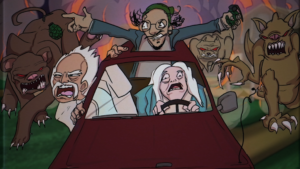
MJE: While not directly analogous to something as historically significant as the Vietnam War, the film does delve into contemporary cultural conflicts. Observing the variety of interpretations that viewers bring to the table is fascinating. I believe that the beauty of any artistic work lies in its ability to evoke diverse perspectives and meanings unique to each individual’s experiences and viewpoints.
I’m cautious about prescribing a specific interpretation or message for the audience. I’d rather keep it an open dialogue than a didactic statement. The different interpretations I’ve seen affirm the film’s relevance across various cultural and social contexts.
8) Two Smash-Mouths? Your co-director and co-producer, Sophia Cacciola, is also your wife. How would you describe your collaboration? What different elements do you each bring to your productions? When you’re working on a project, is there a work/life balance—does work ever really stop?
 The film production nerve center
The film production nerve centerMJE: We have been collaborators for about two decades, first in music and then film. We have a great way of supporting each other and dividing up projects. I do more writing, work with actors on set, and post-production. She tends to do more pre-production, production design (she made many posters and art elements for the films), cinematography, and technical management.
Our work is pretty much our life, so there is no balance. Ha!
9) Italian Style. I mentioned Mario Bava as a possible influence for End Zone 2 (I see it in the use of color and the framing of certain shots, perhaps recalling Blood and Black Lace, 1964, as a fellow proto-slasher). End Zone 2 has “rescued” Italian credits, I can see room for influence from early Dario Argento or Lucio Fulci, and The Once and Future Smash alludes to Ruggero Deodato and Umberto Lenzi. You also include Claudio Fragasso. Why does Italian horror seem like such a prominent influence both diegetically and extra-diegetically on your mockumentary and the film within the mockumentary?
MJE: Our profound admiration for Italian horror cinema significantly influences our work. These films are renowned for their unconstrained creativity and occasional disregard for conventional logic, which we find incredibly inspiring. We always aim to infuse our project with this same sense of unique storytelling that characterizes Italian horror.
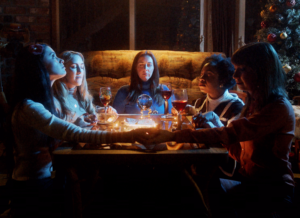 A seance from End Zone 2, perhaps a rarity in American slashers but right at home in Italian counterparts
A seance from End Zone 2, perhaps a rarity in American slashers but right at home in Italian counterpartsThe credits concept came in a late-night, sleep-deprived stupor where Sophia remarked that it would be funny if the credits section could only be restored from an Italian print. For those unfamiliar with these kinds of restorations, it’s common for different sections or scenes to have only been found in specific-language prints. For example, the current English restored version of Deep Red contains a few scenes that are in Italian with subtitles. We thought about dubbing a few scenes like that but decided the titles being in Italian was enough of an homage.
10) Access! How can people learn more about you, view your films, purchase your films, and generally get access to your world (please provide any links you want to share)?
MJE: We are currently running a Kickstarter campaign to clean up and finish some elements of the film and to do a proper physical release of both films on blu-ray, End Zone 2 on VHS, and a novelization of End Zone 2 that includes the missing ending! We’ve turned down over a dozen distribution offers and decided to self-release the films in early 2024.
Our other films can be found via our website, Launch Over – https://launchover.com/
I can also be found on various social media sites at https://linktr.ee/michaeljepstein
About the Filmmaker Click for a treasure trove on YouTube
Click for a treasure trove on YouTubeMichael J. Epstein is an award-losing filmmaker, writer, musician, and scientist known primarily for horror and sci-fi feature films layered with modern sociopolitical commentary, including the horror-culture mockumentary The Once and Future Smash (2024), the experimental film anthology The Transformations of the Transformations of Drs. Jenkins (2021), social-satire-horror Clickbait (2019), 70s-Euro-vampire Blood of the Tribades (2016), psychotronic-sci-fi Magnetic (2015), and the avant-mystery Ten (2014). He often co-writes, co-directs, and co-produces with his wife, Sophia Cacciola, with their production company, Launch Over. Prior to his film career, Michael toured and recorded with indie bands The Motion Sick, The Michael J. Epstein Memorial Library, Neutral Uke Hotel, and Do Not Forsake Me Oh My Darling. He has also published more than 40 book chapters, papers, and abstracts in the auditory and psychological sciences and has written books on crowdfunding and the logical structures of science, mathematics, and statistics.
The post Interview with Filmmaker Michael J. Epstein: The Once and Future Smash appeared first on L. Andrew Cooper's Horrific Scribblings.
December 13, 2023
Spotlight on Author Wrath James White: Poisoning Eros, The Ecstasy of Agony, Rabbit Hunt, and More
Some call him the king of hardcore horror. He certainly mixes extreme imagery with intelligent prose and poetry like few others do—or could. I am proud to present an interview with the brilliant and devastating storyteller and poet Wrath James White.
 Click to find Wrath’s Amazon Author page
Click to find Wrath’s Amazon Author page
 Click to find Wrath on Goodreads
Click to find Wrath on Goodreads
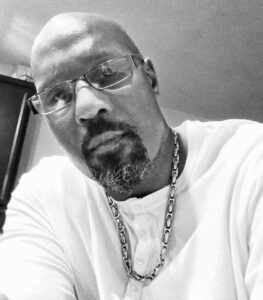 Click to find Wrath on Google Books
Poisoning Eros
(with Monica J. O’Rourke)
Click to find Wrath on Google Books
Poisoning Eros
(with Monica J. O’Rourke)Sometimes life is unfair. Sometimes life just plain sucks. You do what you can to get by, but sometimes even that isn’t enough.
Meet Gloria, aging porno star, drug addict, failed wife and mother—seduced into a monstrous world of depraved sex and violent deceit, battling to save her immortal soul and that of her only daughter from Inferno … and you thought your life was hell.
The heavyweight of hardcore horror returns with ten hard hitting new short stories and seven brutal epic poems exploring the darkest soul of humanity and the cruelty of life without pulling punches. Wrath James White turns his unflinching eye upon the gruesome, the violent, the tragic, and the erotic. Follow a man as he pushes himself through a “body transformation workout” in an attempt to survive a zombie onslaught. Read a poetic account of junkies addicted to a drug that rots their flesh who battle each other arena-style, hoping to survive until the next fix. Consider the consequences of what might happen if the cells you shed in the natural passage of time came back to haunt you. Ponder a new drug that creates radical highs and even more radical aggression—and much, much more.
Rabbit HuntSix college kids go into the woods to drop acid, eat mushrooms, smoke weed, commune with nature, and have sex. But they aren’t alone. There are others who have come to fill the woods with screams and vent their homicidal anger and perverse desires on whomever they find.
Mooky, Rashad, Steve, and Big Mike haven’t gone hunting together since their college days. Marriage, kids, and careers have kept them busy and left little time for hanging out with the boys. But that all changes this weekend. For the first time in years, the boys are going on a little rabbit hunt, and the woods will echo with screams.
Taking the “redneck psychopaths in the woods” trope and turning it on its head, the heavyweight of hardcore horror brings you a tale of extreme violence as only he can deliver it.
The Interview1) I discovered you through reading Poisoning Eros and through my interview with Monica J. O’Rourke, but that’s simply because my head was in the sand: you have an amazing publication record, both on your own and in other collaborative work. In fact, you’ve collaborated with many of your fellow masters of hardcore horror, including Edward Lee and J.F. Gonzalez. What draws you to collaboration? How do you feel about your collaborative works versus your solo endeavors?
WJW: I originally began collaborating as a way to give up control. It was more about personal betterment and development than it was about the story. See, I can be a bit of a control freak. I’m a militant individualist. I don’t even like team sports. Collaborating forced me to learn to play well with others.
I can recall when I collaborated with Lee on Teratologist, and some reviews and comments on social media barely mentioned me and kept calling it “Ed Lee’s new book.” Monica asked me if it bothered me, and it really didn’t. I was just happy we had written something I was proud of and got paid for it. It paid off in the long run.
I love the collaborations I have done, but I am understandably proudest of my solo work.

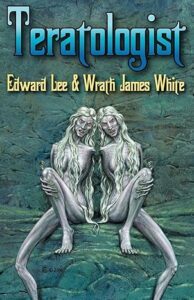
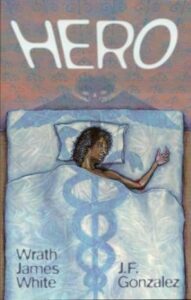
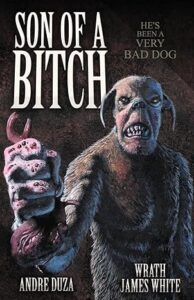
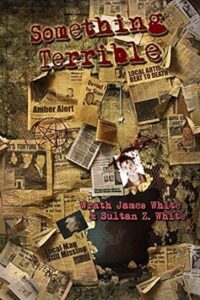
2) In her interview, Monica says we can thank you for the moral dimension of Gloria’s battle through hell in Poisoning Eros. To rephrase an issue I raised with her, I see tension in the book between a repudiation of what Nietzsche would call the “herd morality” that poisons eros and a condemnation of Gloria despite narration from her perspective (like John Milton taking Satan’s perspective to show its flaws in Paradise Lost). What do you think—does this book lean more toward the Nietzschean or the Miltonic? Why? What is the book’s moral vision?
WJW: My idea for the book was to show a true hero’s journey from the very lowest depths, an HIV infected, heroin addicted, former porn star doing donkey shows for drug money who rises to become the ruler of hell. I wanted it to be a critical view of the Christian vision of heaven and hell. In that way, it shares more similarities with Milton than Nietzsche, though I think Nietzsche would have approved.
3) The Ecstasy of Agony expands your work’s moral purview with stories such as “99 Cent.” “First Person Shooter” offers a cutting moral critique of the influence of violent video games like Grand Theft Auto on players, especially young ones. Does this critique of hardcore, violent video games apply to hardcore, violent horror fiction? Why or why not? Many people who condemn violent video games also condemn violent fiction. What would you if say in response if such people attacked your work?
WJW: It isn’t so much a critique of hardcore video games as it is a critique of the hypocrisy behind those who play Grand Theft Auto or Mortal Combat yet would think extreme horror authors are morally bankrupt for what we write. In video games the player is an active participant in the violence. In books the reader has a more voyeuristic role. I don’t think either would drive an otherwise peaceful person to commit murder.
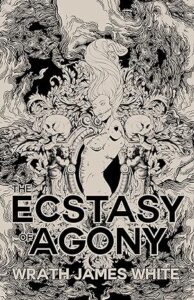
4) Many stories and poems in The Ecstasy of Agony meditate on masculinity. “Seven Years” and “The Devil in the River,” for example, reflect on young Black men growing up in the ghetto, while “Big Game Hunter” and “Horse” take an interest in gay male identities, and “Big Brother” reflects on a racist stereotype about Black men in a way that is… inimitable. To what extent does a desire to represent and reflect upon masculinity inform your creative process? What do you want readers to take away from this strain of social realism’s combination with your trademark extremity?
WJW: I used to have a very “alpha male” view on masculinity. A man’s worth was measured by his ability to protect and provide, how well he fought, and the size of his penis. That changed as I grew up. Leaving Philadelphia at 19 years old, seeing more of the country, and more of the world, being exposed to different viewpoints, and different lifestyles, challenged those assumptions and prejudices I had been raised with.
So much of what those outdated ideas labeled “masculinity” are merely accidents of birth, even including one’s ability to provide for their mates or their family. Does the fact that one person was born into a wealthy family rather than poverty make them more masculine? What about someone having the genes to be a six-foot-five, two-hundred and thirty pound behemoth as a opposed to a slim five-foot-seven? Does that make them more masculine? What if they are born gay or trans? Does being born with sex organs that are above average in length or girth make one more masculine? If you lose your penis are you no longer a man?
The phallus has been almost deified in many cultures, including Black American culture. It’s ridiculous when you think about it. It’s far too arbitrary to be meaningful, yet so many people in our culture still hold those views of masculinity. I wanted to shatter that. In “Big Game Hunter” I show how many gay men, particularly gay Leathermen, can be uber masculine, even more so than heterosexual men. In “Big Brother” I wanted to expose the objectification and fetishization of Black men for their sexuality. All of these traditional measurements of masculinity are extremely toxic and therefore perfect fodder for horror.
5) Your poetry in The Ecstasy of Agony focuses on narrative, deep use of first-person perspective, and careful repetition. How do you determine which stories are poetic and which are pure prose? How do you know when and what to repeat to create the images and rhythms of your poems?
WJW: When I sit down to write a poem that’s the focus. Not just to tell a story, but to write poetry. I look for ideas that would lend themselves to verse, just as I search for ideas that would make good novels. Sometimes a writer might begin writing a short story then realize it would work much better as a novel, and vice versa. That doesn’t really happen with poetry. I have never had a poem become a short story. I would consider that a failure.
Discipline and control are inherent in the medium. The poet has to maintain control over the story so it doesn’t blow up into something that wouldn’t fit into a poetic structure. I do that by choosing each word carefully. The poems are meant to be read aloud, so the word choices, including the repetitive phrases, are dictated by how they sound when spoken and the impact I imagine them having upon the reader or the listener.
6) Some of your stories in The Ecstasy of Agony, such as “Blue and Red” and “Horse,” have sharp political edges. What reactions do you hope to get from the political content, and what reactions do you actually get? Have you had trouble with critics or other readers complaining that hardcore horror and political statements don’t mix?
WJW: I have often said my best stories come from arguments. Something vexes me or rouses my ire, and I put it in a story. With the current political climate being what it is, I think readers expect me to comment on it. I don’t believe every story needs to make some profound sociopolitical statement, but the best stories do, in my opinion. The books that seem to be most popular now are the ones that are pure escapism. Gross for the sake of gross or just a fun violent romp. I enjoy those books, too, but they don’t really leave an impression upon me. I want my books to stay on the reader’s mind and give them something to think about, perhaps cause them to rethink their opinions. Whenever I hear from a reader who says something I wrote made them change their view on a subject, I am overjoyed. Unfortunately, it doesn’t happen as often as I would like.
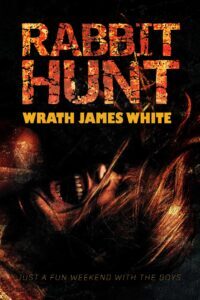 Available at WrathJWHorror.com 12/13/23–this post’s publication date!
Available at WrathJWHorror.com 12/13/23–this post’s publication date!7) The beginning of your description for Rabbit Hunt, about a group of college kids heading to the woods to do drugs and have sex, sounds a bit like the setup for a slasher story, in which such kids would typically be butchered in nasty ways as (usually implied) punishment for the drugs and sex. What, if any, sympathy does Rabbit Hunt have for this group of kids? Do their fates involve a moral commentary on their illicit behavior? Why or why not?
WJW: There is an underlying moral message, or perhaps a sociopolitical one, but it has nothing to do with drugs or sex. Rabbit Hunt takes a look at racism from a more humorous viewpoint. In the past, when I have tackled such subjects, I have done so very seriously. 400 Days of Oppression is a good example of that. Aside from the sex, it’s almost joyless. This time I wanted it to be more like a very brutal, very gory skit from the Chappelle show. I wanted it to be so over the top the reader can’t help but laugh even as they wince and groan. If you can imagine what it would be like if Dave Chappelle wrote an extreme horror novel, you’d probably get something like Rabbit Hunt.
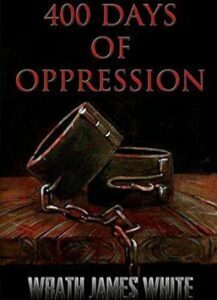
8) The description of Rabbit Hunt also promises that the story turns the trope of “redneck psychopaths in the woods” on its head. Minimizing spoilers, could you share a little about what you do with this trope and how Rabbit Hunt challenges expectations?
WJW: Well, first the antagonists aren’t inbred rednecks. They are from the city and just travel to the forest to wreak havoc. Other than that, I can’t really say much without giving it all away.
9) Of course, readers will expect “extreme violence” from Rabbit Hunt. Again, minimizing spoilers, could you share some tastes of the horrific images and events that you have in store? In addition to these horrors, have you also built in some of the social commentary that runs throughout The Ecstasy of Agony? If so, what social issues do you target?
WJW: There’s a scene involving tree branches that would satiate the hunger of the most jaded gorehound. There’s also a juicy scene that involves a cheese grater and an apple corer. There’s torture, dismemberment, cannibalism. It’s pretty extreme. This is one of the few books I would be comfortable identifying as “Splatterpunk” in the historical sense. And, as I said, there’s a lot of commentary on racism.
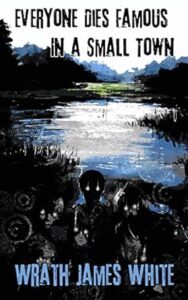
10) Your works Pure Hate and Everyone Dies Famous in a Small Town were recently rereleased by Madness Heart Press. What insights might draw readers to these newly-available works?
WJW: I actually made a post on my Substack page about the events in my personal life that influenced Pure Hate: https://wrathjwhorror.substack.com/p/the-story-behind-pure-hate It’s an ultimate revenge tale.
Everyone Dies Famous In A Small Town is as close as I can get to quiet or cozy horror. It has some graphic sexual scenes, but there’s minimal gore. It’s sort of a ghost story involving Native American folklore.
About the Author Click to subscribe to Wrath’s newsletter!
Click to subscribe to Wrath’s newsletter!Wrath James White is a former World Class Heavyweight Kickboxer, a professional Kickboxing and Mixed Martial Arts trainer, distance runner, performance artist, and former street brawler, who is now known for creating some of the most disturbing works of fiction in print.
Wrath is the author of such extreme horror classics as The Resurrectionist (now a major motion picture titled Come Back to Me), Succulent Prey and its sequel Prey Drive, Yaccub’s Curse, 400 Days of Oppression, Sacrifice, Voracious, To the Death, The Reaper, Skinzz, Everyone Dies Famous in a Small Town, The Book of a Thousand Sins, His Pain, Population Zero, If You Died Tomorrow I Would Eat Your Corpse, Hardcore Kelli, and many others. He is the co-author of Teratologist co-written with the king of extreme horror Edward Lee, Something Terrible co-written with his son Sultan Z. White, Orgy of Souls co-written with Maurice Broaddus, Hero and The Killings both co-written with J.F. Gonzalez, Poisoning Eros co-written with Monica J. O’Rourke, Master of Pain co-written with Kristopher Rufty, and Boy’s Night co-written with Matt Shaw among others.
Wrath lives and works in Austin, TX.
Andrew’s ReviewsPoisoning Eros, with Monica J. O’Rourke (2016 edition)When my brain tries to process Poisoning Eros, a literary onslaught of sexual violation and myriad other forms of visceral violence, it retreats into classics. For its interest in the miseries of Inferno, I go to Dante, and I find a similar urge to map and describe a great variety of tortures. For its underlying morality play infused with Nietzschean insight—which I discuss with both White and O’Rourke in our interviews—I go to Milton. For the admittedly somewhat repetitive scenes of rape and flesh torn asunder, I go to the Marquis de Sade. Poisoning Eros’s effectiveness comes from being like all of these and none. Dante’s perspective character, Dante, is a tourist in Hell. In Poisoning Eros, Gloria, the central character, similarly explores Hell but is a participant in its horrors in ways that range from passive to very active. Gloria faces moral questions that will be familiar to readers of Paradise Lost, but such readers will likely notice the questions’ distinctly contemporary edge, and they’ll also notice that Milton never asks questions about whether fucking a giraffe is the right thing to do. As for the Marquis de Sade, he lies behind many an extreme horror tale. Interestingly, Gloria has a bit in common with both Sade’s Justine and Sade’s Juliette, both ultimate victim and ultimate libertine, and though her journey isn’t directly comparable to either of Sade’s characters’, it has shades of both. All these comparisons are more than an exercise. You could read Poisoning Eros as merely a bare-bones narrative about a drug-addled porno actress who gets dragged to hell along with her daughter and tries to save the girl and escape—a bare-bones narrative that allows for an almost ceaseless gorefest—but you’d miss quite a lot. Poisoning Eros is an almost ceaseless gorefest, but it is as intellectually rewarding as it is viscerally unsettling.
The Ecstasy of Agony (2023 edition)Wrath James White is a master storyteller and pulse-pounding poet, and he plays both roles in The Ecstasy of Agony, a collection of horrific short stories and poems, all seventeen of which tend to be as artful and hardcore as his longer prose works. With, and sometimes through, the violence, White offers social and political insights that deepen his fictional worlds, the characters, and sometimes even the suspense. Larger interests include varied perspectives on masculinity, addiction, racism, and particularly the intersection of race and economics, but each story or poem brings something special to the fore. The opening story, “Beast Mode,” considers the limits of the human body as a source of hope in what might be a hopeless situation (maybe life itself?). “First Person Shooter” offers a parallel—that becomes an intersection—between street violence and video game violence. Two of my favorites, the poem “Krokodil” and the story “Seven Years,” rely on a bit of science fiction. “Seven Years” follows several narrative strands; the idea that humans replace virtually all our cells every seven years brings those strands together. “Krokodil” describes arena-style combat among addicts to a drug that makes their flesh rot while they’re still alive. White’s verse is rhythmic, and he knows how to repeat phrases for impact. For example, in another poem, “Screams in Bobby’s Eyes,” repetitions of “When the hammer struck” and “When the screwdriver pierced” quite vividly drive points home. This collection is grim, but it doesn’t lack humor. “Big Game Hunter,” a story about a gay man who hunts other gay men, takes a surprising turn that made me snicker. The final story, “Big Brother,” gruesomely, uh, skewers a racist stereotype, and I couldn’t stop smiling. Overall, the book is diverse, thoughtful, hardcore fun, highly recommended as an introduction to White’s gruesome and horrific ways (as it was for me) or as an expansion of your Wrath James White library.
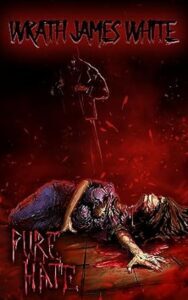 Pure Hate
(2023 edition)
Pure Hate
(2023 edition)Pure Hate is a story of revenge and obsession taken to (almost) unthinkable extremes, a fast-paced, suspenseful tale with cat-and-mouse dynamics that shift among the police, a serial killer, and the serial killer’s primary targets as horrifically mangled bodies pile up around the city of Philadelphia. Roughly the first half plays like a thriller—or would if White didn’t decorate it with his trademark hardcore violence, truly exquisite gruesomeness that enhances the experience and pushes it over the line into horror. Nevertheless, I felt at times like I was reading a really, really good episode of Criminal Minds, following one street-smart and one book-smart cop as they try to figure out a serial killer who defies familiar patterns. White isn’t content to let his book work in only one mode, however, and shifts midway toward an emphasis on the perspectives of the killer and the object(s) of his obsession, making the horror more intimate and scarier. His characters are deeply flawed but still relatable, even the killer (for one reason why, be sure the follow the link in question ten of the interview above). I found the book difficult to stop reading, so I didn’t do much reflection along the way, but afterward I felt like I had just read one of the most insightful literary studies of masculinity that I’ve encountered since I last read Ernest Hemingway in my early 20s. White has much to say about power differentials between men and women (a lot of it disturbing), but he excels at depicting investments in body image, anxieties about social standing, struggles for interpersonal control, uncertainties about emotional expression and repression, and many other issues associated with “being a man.” Such issues aren’t tangential or add-ons: they ultimately lie at the heart of the story, propelling the killer and his obsession. Behind Pure Hate’s passion is an analytical mind that delivers a layered experience, a read that’s fun and liable to stay with you.
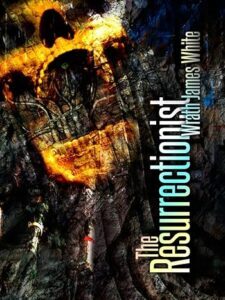 The Resurrectionist
(2014 edition)
The Resurrectionist
(2014 edition)Probably White’s calling-card novel at this point, The Resurrectionist grows from a deceptively simple, speculative premise, indicated by its title. What if a young man had the power to bring people back to life? What if, instead of being someone who would use such power for good, that young man were a sexual sadist who uses the power to torture, rape, murder, and then resurrect women so he can repeat his pleasures night after night? White adds to the mix that the people his Resurrectionist, Dale, brings back don’t remember the horrific things that have happened to them, introduces the character, switches to the perspective of one of his female victims, Sarah, and lets the story unwind its horrors. The first half, mostly from Sarah’s perspective, plays with the nerve-racking tension of a classic Gothic novel: the female protagonist knows things are happening to her, knows she is in grave danger, but no one (except the reader, of course) believes her, so she feels increasingly helpless and trapped. Like in Pure Hate, however, White doesn’t let his novel linger in that mode, as eventually Sarah gains credibility, and the conflict broadens along with the number of brutally mutilated—then resurrected—victims. Sarah, her husband Josh, and Dale are well-developed characters, Sarah smart and sympathetic, Josh conflicted and haunted, Dale psychologically accessible, at least to a point, but terrifying in being so. The book, which features a lot of graphic rape, is also surprisingly thoughtful about rape, self-conscious and inclusive of multiple perspectives (none but the killer’s approving, of course). An unexpected layer of insight also comes from the setting in Las Vegas after the post-2008 economic downturn. Abandoned houses and the unavailability of jobs become plot points as well as reminders of poverty’s far-reaching impact. The Resurrectionist is exceptionally well-crafted, a very rewarding read that is rightfully already a classic of hardcore horror and deserves to be counted among the more general horror classics of the early twenty-first century.
NOTE: The Resurrectionist has been adapted into a film, Come Back to Me (2014). I don’t generally require adaptations and remakes to be “faithful” to their precursors; films must reflect their medium and historical contexts. By industry standards, White’s novel’s extremity is unfilmable and had to be changed; I can accept that. However, this film’s withholding of the information indicated by White’s title as a sort of twist later in the film doesn’t really work, and failure to develop Josh’s character or the police characters (the latter of which might have been a budgetary decision) makes the film feel two-dimensional. In short, I can’t really recommend it, but it’s not terrible, so if you’re curious after you read the book, why not?
The post Spotlight on Author Wrath James White: Poisoning Eros, The Ecstasy of Agony, Rabbit Hunt, and More appeared first on L. Andrew Cooper's Horrific Scribblings.
Spotlight on Wrath James White: Poisoning Eros, The Ecstasy of Agony, Rabbit Hunt, and More
Some call him the king of hardcore horror. He certainly mixes extreme imagery with intelligent prose and poetry like few others do—or could. I am proud to present an interview with the brilliant and devastating storyteller and poet Wrath James White.
 Click to find Wrath’s Amazon Author page
Click to find Wrath’s Amazon Author page
 Click to find Wrath on Goodreads
Click to find Wrath on Goodreads
 Click to find Wrath on Google Books
Poisoning Eros
(with Monica J. O’Rourke)
Click to find Wrath on Google Books
Poisoning Eros
(with Monica J. O’Rourke)Sometimes life is unfair. Sometimes life just plain sucks. You do what you can to get by, but sometimes even that isn’t enough.
Meet Gloria, aging porno star, drug addict, failed wife and mother—seduced into a monstrous world of depraved sex and violent deceit, battling to save her immortal soul and that of her only daughter from Inferno … and you thought your life was hell.
The heavyweight of hardcore horror returns with ten hard hitting new short stories and seven brutal epic poems exploring the darkest soul of humanity and the cruelty of life without pulling punches. Wrath James White turns his unflinching eye upon the gruesome, the violent, the tragic, and the erotic. Follow a man as he pushes himself through a “body transformation workout” in an attempt to survive a zombie onslaught. Read a poetic account of junkies addicted to a drug that rots their flesh who battle each other arena-style, hoping to survive until the next fix. Consider the consequences of what might happen if the cells you shed in the natural passage of time came back to haunt you. Ponder a new drug that creates radical highs and even more radical aggression—and much, much more.
Rabbit HuntSix college kids go into the woods to drop acid, eat mushrooms, smoke weed, commune with nature, and have sex. But they aren’t alone. There are others who have come to fill the woods with screams and vent their homicidal anger and perverse desires on whomever they find.
Mooky, Rashad, Steve, and Big Mike haven’t gone hunting together since their college days. Marriage, kids, and careers have kept them busy and left little time for hanging out with the boys. But that all changes this weekend. For the first time in years, the boys are going on a little rabbit hunt, and the woods will echo with screams.
Taking the “redneck psychopaths in the woods” trope and turning it on its head, the heavyweight of hardcore horror brings you a tale of extreme violence as only he can deliver it.
The Interview1) I discovered you through reading Poisoning Eros and through my interview with Monica J. O’Rourke, but that’s simply because my head was in the sand: you have an amazing publication record, both on your own and in other collaborative work. In fact, you’ve collaborated with many of your fellow masters of hardcore horror, including Edward Lee and J.F. Gonzalez. What draws you to collaboration? How do you feel about your collaborative works versus your solo endeavors?
WJW: I originally began collaborating as a way to give up control. It was more about personal betterment and development than it was about the story. See, I can be a bit of a control freak. I’m a militant individualist. I don’t even like team sports. Collaborating forced me to learn to play well with others.
I can recall when I collaborated with Lee on Teratologist, and some reviews and comments on social media barely mentioned me and kept calling it “Ed Lee’s new book.” Monica asked me if it bothered me, and it really didn’t. I was just happy we had written something I was proud of and got paid for it. It paid off in the long run.
I love the collaborations I have done, but I am understandably proudest of my solo work.





2) In her interview, Monica says we can thank you for the moral dimension of Gloria’s battle through hell in Poisoning Eros. To rephrase an issue I raised with her, I see tension in the book between a repudiation of what Nietzsche would call the “herd morality” that poisons eros and a condemnation of Gloria despite narration from her perspective (like John Milton taking Satan’s perspective to show its flaws in Paradise Lost). What do you think—does this book lean more toward the Nietzschean or the Miltonic? Why? What is the book’s moral vision?
WJW: My idea for the book was to show a true hero’s journey from the very lowest depths, an HIV infected, heroin addicted, former porn star doing donkey shows for drug money who rises to become the ruler of hell. I wanted it to be a critical view of the Christian vision of heaven and hell. In that way, it shares more similarities with Milton than Nietzsche, though I think Nietzsche would have approved.
3) The Ecstasy of Agony expands your work’s moral purview with stories such as “99 Cent.” “First Person Shooter” offers a cutting moral critique of the influence of violent video games like Grand Theft Auto on players, especially young ones. Does this critique of hardcore, violent video games apply to hardcore, violent horror fiction? Why or why not? Many people who condemn violent video games also condemn violent fiction. What would you if say in response if such people attacked your work?
WJW: It isn’t so much a critique of hardcore video games as it is a critique of the hypocrisy behind those who play Grand Theft Auto or Mortal Combat yet would think extreme horror authors are morally bankrupt for what we write. In video games the player is an active participant in the violence. In books the reader has a more voyeuristic role. I don’t think either would drive an otherwise peaceful person to commit murder.

4) Many stories and poems in The Ecstasy of Agony meditate on masculinity. “Seven Years” and “The Devil in the River,” for example, reflect on young Black men growing up in the ghetto, while “Big Game Hunter” and “Horse” take an interest in gay male identities, and “Big Brother” reflects on a racist stereotype about Black men in a way that is… inimitable. To what extent does a desire to represent and reflect upon masculinity inform your creative process? What do you want readers to take away from this strain of social realism’s combination with your trademark extremity?
WJW: I used to have a very “alpha male” view on masculinity. A man’s worth was measured by his ability to protect and provide, how well he fought, and the size of his penis. That changed as I grew up. Leaving Philadelphia at 19 years old, seeing more of the country, and more of the world, being exposed to different viewpoints, and different lifestyles, challenged those assumptions and prejudices I had been raised with.
So much of what those outdated ideas labeled “masculinity” are merely accidents of birth, even including one’s ability to provide for their mates or their family. Does the fact that one person was born into a wealthy family rather than poverty make them more masculine? What about someone having the genes to be a six-foot-five, two-hundred and thirty pound behemoth as a opposed to a slim five-foot-seven? Does that make them more masculine? What if they are born gay or trans? Does being born with sex organs that are above average in length or girth make one more masculine? If you lose your penis are you no longer a man?
The phallus has been almost deified in many cultures, including Black American culture. It’s ridiculous when you think about it. It’s far too arbitrary to be meaningful, yet so many people in our culture still hold those views of masculinity. I wanted to shatter that. In “Big Game Hunter” I show how many gay men, particularly gay Leathermen, can be uber masculine, even more so than heterosexual men. In “Big Brother” I wanted to expose the objectification and fetishization of Black men for their sexuality. All of these traditional measurements of masculinity are extremely toxic and therefore perfect fodder for horror.
5) Your poetry in The Ecstasy of Agony focuses on narrative, deep use of first-person perspective, and careful repetition. How do you determine which stories are poetic and which are pure prose? How do you know when and what to repeat to create the images and rhythms of your poems?
WJW: When I sit down to write a poem that’s the focus. Not just to tell a story, but to write poetry. I look for ideas that would lend themselves to verse, just as I search for ideas that would make good novels. Sometimes a writer might begin writing a short story then realize it would work much better as a novel, and vice versa. That doesn’t really happen with poetry. I have never had a poem become a short story. I would consider that a failure.
Discipline and control are inherent in the medium. The poet has to maintain control over the story so it doesn’t blow up into something that wouldn’t fit into a poetic structure. I do that by choosing each word carefully. The poems are meant to be read aloud, so the word choices, including the repetitive phrases, are dictated by how they sound when spoken and the impact I imagine them having upon the reader or the listener.
6) Some of your stories in The Ecstasy of Agony, such as “Blue and Red” and “Horse,” have sharp political edges. What reactions do you hope to get from the political content, and what reactions do you actually get? Have you had trouble with critics or other readers complaining that hardcore horror and political statements don’t mix?
WJW: I have often said my best stories come from arguments. Something vexes me or rouses my ire, and I put it in a story. With the current political client being what it is, I think readers expect me to comment on it. I don’t believe every story needs to make some profound sociopolitical statement, but the best stories do, in my opinion. The books that seem to be most popular now are the ones that are pure escapism. Gross for the sake of gross or just a fun violent romp. I enjoy those books, too, but they don’t really leave an impression upon me. I want my books to stay on the reader’s mind and give them something to think about, perhaps cause them to rethink their opinions. Whenever I hear from a reader who says something I wrote made them change their view on a subject, I am overjoyed. Unfortunately, it doesn’t happen as often as I would like.
 There’s no link to a purchase page on this image, but the book is coming soon!
There’s no link to a purchase page on this image, but the book is coming soon!7) The beginning of your description for Rabbit Hunt, about a group of college kids heading to the woods to do drugs and have sex, sounds a bit like the setup for a slasher story, in which such kids would typically be butchered in nasty ways as (usually implied) punishment for the drugs and sex. What, if any, sympathy does Rabbit Hunt have for this group of kids? Do their fates involve a moral commentary on their illicit behavior? Why or why not?
WJW: There is an underlying moral message, or perhaps a sociopolitical one, but it has nothing to do with drugs or sex. Rabbit Hunt takes a look at racism from a more humorous viewpoint. In the past, when I have tackled such subjects, I have done so very seriously. 400 Days of Oppression is a good example of that. Aside from the sex, it’s almost joyless. This time I wanted it to be more like a very brutal, very gory skit from the Chappelle show. I wanted it to be so over the top the reader can’t help but laugh even as they wince and groan. If you can imagine what it would be like if Dave Chappelle wrote an extreme horror novel, you’d probably get something like Rabbit Hunt.

8) The description of Rabbit Hunt also promises that the story turns the trope of “redneck psychopaths in the woods” on its head. Minimizing spoilers, could you share a little about what you do with this trope and how Rabbit Hunt challenges expectations?
WJW: Well, first the antagonists aren’t inbred rednecks. They are from the city and just travel to the forest to wreak havoc. Other than that, I can’t really say much without giving it all away.
9) Of course, readers will expect “extreme violence” from Rabbit Hunt. Again, minimizing spoilers, could you share some tastes of the horrific images and events that you have in store? In addition to these horrors, have you also built in some of the social commentary that runs throughout The Ecstasy of Agony? If so, what social issues do you target?
WJW: There’s a scene involving tree branches that would satiate the hunger of the most jaded gorehound. There’s also a juicy scene that involves a cheese grater and an apple corer. There’s torture, dismemberment, cannibalism. It’s pretty extreme. This is one of the few books I would be comfortable identifying as “Splatterpunk” in the historical sense. And, as I said, there’s a lot of commentary on racism.

10) Your works Pure Hate and Everyone Dies Famous in a Small Town were recently rereleased by Madness Heart Press. What insights might draw readers to these newly-available works?
WJW: I actually made a post on my Substack page about the events in my personal life that influenced Pure Hate: https://wrathjwhorror.substack.com/p/the-story-behind-pure-hate It’s an ultimate revenge tale.
Everyone Dies Famous In A Small Town is as close as I can get to quiet or cozy horror. It has some graphic sexual scenes, but there’s minimal gore. It’s sort of a ghost story involving Native American folklore.
About the Author Click to subscribe to Wrath’s newsletter!
Click to subscribe to Wrath’s newsletter!Wrath James White is a former World Class Heavyweight Kickboxer, a professional Kickboxing and Mixed Martial Arts trainer, distance runner, performance artist, and former street brawler, who is now known for creating some of the most disturbing works of fiction in print.
Wrath is the author of such extreme horror classics as The Resurrectionist (now a major motion picture titled Come Back to Me), Succulent Prey and its sequel Prey Drive, Yaccub’s Curse, 400 Days of Oppression, Sacrifice, Voracious, To the Death, The Reaper, Skinzz, Everyone Dies Famous in a Small Town, The Book of a Thousand Sins, His Pain, Population Zero, If You Died Tomorrow I Would Eat Your Corpse, Hardcore Kelli, and many others. He is the co-author of Teratologist co-written with the king of extreme horror Edward Lee, Something Terrible co-written with his son Sultan Z. White, Orgy of Souls co-written with Maurice Broaddus, Hero and The Killings both co-written with J.F. Gonzalez, Poisoning Eros co-written with Monica J. O’Rourke, Master of Pain co-written with Kristopher Rufty, and Boy’s Night co-written with Matt Shaw among others.
Wrath lives and works in Austin, TX.
Andrew’s ReviewsPoisoning Eros, with Monica J. O’Rourke (2016 edition)When my brain tries to process Poisoning Eros, a literary onslaught of sexual violation and myriad other forms of visceral violence, it retreats into classics. For its interest in the miseries of Inferno, I go to Dante, and I find a similar urge to map and describe a great variety of tortures. For its underlying morality play infused with Nietzschean insight—which I discuss with both White and O’Rourke in our interviews—I go to Milton. For the admittedly somewhat repetitive scenes of rape and flesh torn asunder, I go to the Marquis de Sade. Poisoning Eros’s effectiveness comes from being like all of these and none. Dante’s perspective character, Dante, is a tourist in Hell. In Poisoning Eros, Gloria, the central character, similarly explores Hell but is a participant in its horrors in ways that range from passive to very active. Gloria faces moral questions that will be familiar to readers of Paradise Lost, but such readers will likely notice the questions’ distinctly contemporary edge, and they’ll also notice that Milton never asks questions about whether fucking a giraffe is the right thing to do. As for the Marquis de Sade, he lies behind many an extreme horror tale. Interestingly, Gloria has a bit in common with both Sade’s Justine and Sade’s Juliette, both ultimate victim and ultimate libertine, and though her journey isn’t directly comparable to either of Sade’s characters’, it has shades of both. All these comparisons are more than an exercise. You could read Poisoning Eros as merely a bare-bones narrative about a drug-addled porno actress who gets dragged to hell along with her daughter and tries to save the girl and escape—a bare-bones narrative that allows for an almost ceaseless gorefest—but you’d miss quite a lot. Poisoning Eros is an almost ceaseless gorefest, but it is as intellectually rewarding as it is viscerally unsettling.
The Ecstasy of Agony (2023 edition)Wrath James White is a master storyteller and pulse-pounding poet, and he plays both roles in The Ecstasy of Agony, a collection of horrific short stories and poems, all seventeen of which tend to be as artful and hardcore as his longer prose works. With, and sometimes through, the violence, White offers social and political insights that deepen his fictional worlds, the characters, and sometimes even the suspense. Larger interests include varied perspectives on masculinity, addiction, racism, and particularly the intersection of race and economics, but each story or poem brings something special to the fore. The opening story, “Beast Mode,” considers the limits of the human body as a source of hope in what might be a hopeless situation (maybe life itself?). “First Person Shooter” offers a parallel—that becomes an intersection—between street violence and video game violence. Two of my favorites, the poem “Krokodil” and the story “Seven Years,” rely on a bit of science fiction. “Seven Years” follows several narrative strands; the idea that humans replace virtually all our cells every seven years brings those strands together. “Krokodil” describes arena-style combat among addicts to a drug that makes their flesh rot while they’re still alive. White’s verse is rhythmic, and he knows how to repeat phrases for impact. For example, in another poem, “Screams in Bobby’s Eyes,” repetitions of “When the hammer struck” and “When the screwdriver pierced” quite vividly drive points home. This collection is grim, but it doesn’t lack humor. “Big Game Hunter,” a story about a gay man who hunts other gay men, takes a surprising turn that made me snicker. The final story, “Big Brother,” gruesomely, uh, skewers a racist stereotype, and I couldn’t stop smiling. Overall, the book is diverse, thoughtful, hardcore fun, highly recommended as an introduction to White’s gruesome and horrific ways (as it was for me) or as an expansion of your Wrath James White library.
 Pure Hate
(2023 edition)
Pure Hate
(2023 edition)Pure Hate is a story of revenge and obsession taken to (almost) unthinkable extremes, a fast-paced, suspenseful tale with cat-and-mouse dynamics that shift among the police, a serial killer, and the serial killer’s primary targets as horrifically mangled bodies pile up around the city of Philadelphia. Roughly the first half plays like a thriller—or would if White didn’t decorate it with his trademark hardcore violence, truly exquisite gruesomeness that enhances the experience and pushes it over the line into horror. Nevertheless, I felt at times like I was reading a really, really good episode of Criminal Minds, following one street-smart and one book-smart cop as they try to figure out a serial killer who defies familiar patterns. White isn’t content to let his book work in only one mode, however, and shifts midway toward an emphasis on the perspectives of the killer and the object(s) of his obsession, making the horror more intimate and scarier. His characters are deeply flawed but still relatable, even the killer (for one reason why, be sure the follow the link in question ten of the interview above). I found the book difficult to stop reading, so I didn’t do much reflection along the way, but afterward I felt like I had just read one of the most insightful literary studies of masculinity that I’ve encountered since I last read Ernest Hemingway in my early 20s. White has much to say about power differentials between men and women (a lot of it disturbing), but he excels at depicting investments in body image, anxieties about social standing, struggles for interpersonal control, uncertainties about emotional expression and repression, and many other issues associated with “being a man.” Such issues aren’t tangential or add-ons: they ultimately lie at the heart of the story, propelling the killer and his obsession. Behind Pure Hate’s passion is an analytical mind that delivers a layered experience, a read that’s fun and liable to stay with you.
 The Resurrectionist
(2014 edition)
The Resurrectionist
(2014 edition)Probably White’s calling-card novel at this point, The Resurrectionist grows from a deceptively simple, speculative premise, indicated by its title. What if a young man had the power to bring people back to life? What if, instead of being someone who would use such power for good, that young man were a sexual sadist who uses the power to torture, rape, murder, and then resurrect women so he can repeat his pleasures night after night? White adds to the mix that the people his Resurrectionist, Dale, brings back don’t remember the horrific things that have happened to them, introduces the character, switches to the perspective of one of his female victims, Sarah, and lets the story unwind its horrors. The first half, mostly from Sarah’s perspective, plays with the nerve-racking tension of a classic Gothic novel: the female protagonist knows things are happening to her, knows she is in grave danger, but no one (except the reader, of course) believes her, so she feels increasingly helpless and trapped. Like in Pure Hate, however, White doesn’t let his novel linger in that mode, as eventually Sarah gains credibility, and the conflict broadens along with the number of brutally mutilated—then resurrected—victims. Sarah, her husband Josh, and Dale are well-developed characters, Sarah smart and sympathetic, Josh conflicted and haunted, Dale psychologically accessible, at least to a point, but terrifying in being so. The book, which features a lot of graphic rape, is also surprisingly thoughtful about rape, self-conscious and inclusive of multiple perspectives (none but the killer’s approving, of course). An unexpected layer of insight also comes from the setting in Las Vegas after the post-2008 economic downturn. Abandoned houses and the unavailability of jobs become plot points as well as reminders of poverty’s far-reaching impact. The Resurrectionist is exceptionally well-crafted, a very rewarding read that is rightfully already a classic of hardcore horror and deserves to be counted among the more general horror classics of the early twenty-first century.
NOTE: The Resurrectionist has been adapted into a film, Come Back to Me (2014). I don’t generally require adaptations and remakes to be “faithful” to their precursors; films must reflect their medium and historical contexts. By industry standards, White’s novel’s extremity is unfilmable and had to be changed; I can accept that. However, this film’s withholding of the information indicated by White’s title as a sort of twist later in the film doesn’t really work, and failure to develop Josh’s character or the police characters (the latter of which might have been a budgetary decision) makes the film feel two-dimensional. In short, I can’t really recommend it, but it’s not terrible, so if you’re curious after you read the book, why not?
The post Spotlight on Wrath James White: Poisoning Eros, The Ecstasy of Agony, Rabbit Hunt, and More appeared first on L. Andrew Cooper's Horrific Scribblings.
December 6, 2023
Guest Post: Celebrating Horror’s Golden Ages by Kendall R. Phillips
The prominence of horror films at the box office and of horror novels on bookshelves suggests that ours is an age obsessed with the monstrous and macabre. Films such as The Invisible Man (2020), Nope (2022), and Talk to Me (2023) have been both critically hailed and commercially successful. Innovative horror novelists such as Stephen Graham Jones, Victor LaValle, Silvia Moreno-Garcia, N.K. Jemisin, and Paul Tremblay have led many bookstores to expand their horror sections, shelves that previously only housed tomes from members of the Stephen King household. The prevalence of horror on page and silver screen has been matched by its popularity on the small screen in television shows such as American Horror Story, The Haunting of Hill House, and 30 Coins and in countless horror-related video games. Indeed, horror narratives are so ubiquitous at the moment I would suggest that we are living in a golden age of horror.
Ours is not, to be clear, the only golden age of horror. In my estimation, we are in the third golden age. The first was that period of the 1930s when the horror genre first emerged as a recognizable category of popular culture. Indeed, it was in 1931, in-between the surprising success of Tod Browning’s Dracula and James Whale’s Frankenstein, that popular publications and movie theaters began using the term “horror film,” and the name stuck. Of course, there were horrific images and stories in motion pictures during the silent era. But those images and stories never quite coalesced into a recognizable genre, and, indeed, American filmmakers generally preferred their ghosts and monsters to be hoaxes or tricks in stories that largely prefigured Scooby Doo. In many of these films, as I discuss in A Place of Darkness: The Rhetoric of Horror in Early American Cinema, the frightening supernatural entity ends up being some uncle trying to steal an inheritance or unscrupulous real estate agent trying to get the “haunted house” at a bargain price.
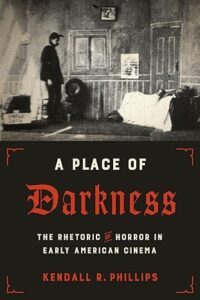 Click the pic for more on Amazon!
Click the pic for more on Amazon!While clearly borrowing from silent era films like The Cabinet of Dr. Caligari (1920) and The Cat and the Canary (1927), Dracula and Frankenstein were different. The monsters in Universal’s horror films were real, and the supernatural was not a hoax or misperception, it was a terrifying threat. In the darkest days of the Great Depression, Americans flocked to theaters to see these and other horrific monsters. The success of Dracula and Frankenstein opened the door for a cavalcade of monsters ranging from The Mummy (1932) to Cat People (1942).
Interestingly, the commercial success of the newly christened “horror films” at the box office led to the emergence of horror programming on the radio. Anthology shows like Light’s Out and The Witch’s Tale premiered in the early 1930s and brought the macabre and horrifying into the homes of everyday citizens through the airwaves. These shows were both so frightening and so popular that there were public calls for their elimination and even proposals for formal governmental censorship to restrict horror on the airwaves. But America’s appetite for the horrific continued.
The first golden age of horror laid the foundation for horror narratives, and throughout the 40s and 50s, horror would continue evolving, shifting from monsters lurking in crumbling castles to creatures arriving from outer space. In 1968, however, that foundation dramatically shifted, and the second golden age of horror began. 1968 could be considered, along with 1931, as one of the best years in the history of horror. Roman Polanski’s Rosemary’s Baby was a box office and Oscar success, but the real herald of a new golden age was released to much less fanfare. Independently produced by a group of Pittsburgh industrial filmmakers, Night of the Living Dead opened the floodgates for a new more brutal, nihilistic, and graphic tone in horror. George Romero’s masterpiece was soon followed by films such as Wes Craven’s Last House on the Left (1972), Tobe Hooper’s Texas Chainsaw Massacre (1974), and John Carpenter’s Halloween (1978). In my book Dark Directions: Romero, Craven, Carpenter and the Modern Horror Film, I argue that these independent filmmakers rewrote the formula for horror and became the architects of a new era of frightening films.
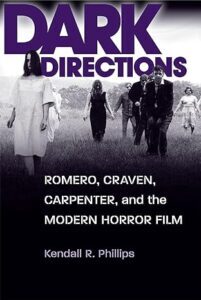
Even as critics typically reviled these low-budget shockers, audiences flocked to midnight screenings to see them, and the studios soon followed along with bigger budget horror films like The Exorcist (1973), The Omen (1976), and Alien (1979).
Perhaps not surprisingly, the prevalence of horror on the silver screen permeated other aspects of American popular culture. Bands like Alice Cooper and Black Sabbath embraced dark tones and macabre tales. Television would also see a dramatic shift in the tone and style of horror narratives. While anthology series such as The Twilight Zone and The Night Gallery had been popular, a crucial shift in horror television occurred in 1972 with the release of a television movie entitled The Night Stalker. This horror movie became the highest rated TV movie in history and led to a second television movie, The Night Strangler (1973), and the short-lived but influential series Kolchak: The Night Stalker (1974-1975). At the heart of The Night Stalker is Carl Kolchak, a tough-talking newspaper reporter who consistently discovers supernatural entities, a vampire in Las Vegas, a werewolf on a cruise ship, a Hindu demon in city alleys. While hampered by a low budget and narrative inconsistencies, the Kolchak episodes proved to television creators that a horror narrative could focus not on the monster or on the victim but on the monster hunter.
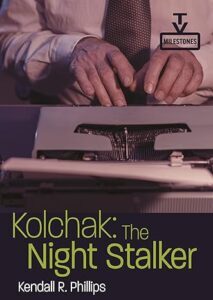
Indeed, as I argue in a recently published entry into the “TV Milestones Series,” Kolchak: The Night Stalker is the foundation upon which shows like Buffy the Vampire Slayer, The X-Files, Supernatural, and Lovecraft Country were developed.
The horror tales of the last decades of the twentieth century continued developing, challenging, and shifting the core structures of the second golden age, but a recent seismic shift may have ushered in a new golden age. If I were to nominate a film as the beginning of this new era, I would pick Jordan Peele’s Get Out (2017). Critically acclaimed and much discussed, Peele’s film may not be the first political horror film, but it is certainly a film that lays out its political critique with explicit and damning clarity. Get Out depicts the systems of white privilege and anti-Black violence in ways that shifted public discussions and set the stage for a renewed interest in and respect for horror. While I am loathe to embrace terms like “elevated” or “smart” horror, I cannot ignore the way contemporary audiences are now turning to horror stories for insights into their culture. Hence, a third golden age of horror has dawned.
Now, to be clear, I don’t talk about golden ages of horror in order to dismiss other periods of the genre. There are, without a doubt, provocative horror films that were produced outside these particular periods – films such as Invasion of the Body Snatchers (1956) and Psycho (1960). But these golden ages tend to be distinct in at least three ways. First, they are periods of remarkably productive horror filmmaking, and, as I’ve suggested above, these films often spark interest in horror across other mediums like print, radio, and television. Second, they are periods in which horror narratives are both popular and provocative. During golden ages, audiences don’t just go to watch horror films, but discuss and debate them. Third, and perhaps most interestingly, each of these golden ages occurs during a period of notable social upheaval: the Great Depression, the violence of the late 1960s, the political turmoil of the late 2010s. Almost twenty years ago, I argued, in a book entitled Projected Fears: Horror Films and American Culture, that horror narratives work best when they “resonate” with the wider anxieties and fears in the culture.
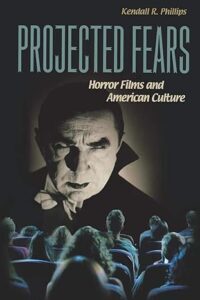
The intervening twenty years have reinforced my sense that horror films perform important rhetorical work for the culture, creating a safer space for engaging that which we fear. The darker the world around us, it would seem, the more likely we are to ponder it through the dark mirror of the horror genre.
About the Author
Kendall R. Phillips is professor of communication and rhetorical studies at Syracuse University, where he researches and teaches about the intersection of politics and popular culture. His work engages topics like public memory, popular film, and popular culture. He has published several books, including: A Cinema of Hopelessness: The Rhetoric of Refusal in 21st Century American Film; A Place of Darkness: The Rhetoric of Horror in Early American Cinema; and Projected Fears: Horror Films and American Culture. His essays have appeared in such journals as Quarterly Journal of Speech, Communication Monographs, and Philosophy and Rhetoric, and he is co-editor for the book series “Horror and Monstrosity Studies” at the University Press of Mississippi and “Rhetoric, Politics, and Society” for Palgrave Macmillan.
The post Guest Post: Celebrating Horror’s Golden Ages by Kendall R. Phillips appeared first on L. Andrew Cooper's Horrific Scribblings.
November 15, 2023
Guest Post: Capsules Movie Explained (with Spoilers) and Trivia Tidbits by Luke Momo
Luke Momo, the multi-faceted filmmaker behind indie horror film opus Capsules, is back to share more about the intricate world of the film as well as some amusing trivia. Yes, there are major spoilers, but knowing this stuff will also give you a richer experience when you see the movie (see the movie!).
For my interview with Luke, look here.
CapsulesThe film centers around four intelligent yet naive college students studying for their chemistry final. Worn out from a week of finals and gearing up to take their toughest one, they stumble upon a mysterious bottle of pills. They decide to take them to have a fun night off before returning to their studies.
 Click the pic for more on Amazon!
Click the pic for more on Amazon!They quickly discover that there’s a catch: if they don’t take another pill every six hours, they will die. They agree to keep taking the pills while trying to figure out how to escape this loop and survive without the pills. They use their knowledge of science and their cunning young minds to try to solve the pressing issue.
They find themselves in increasingly compromising situations that challenge their moral and ethical beliefs and ultimately force them to grow up and confront their own mortality. Capsules is a coming-of-age story told through the scariest drug trip you could imagine.
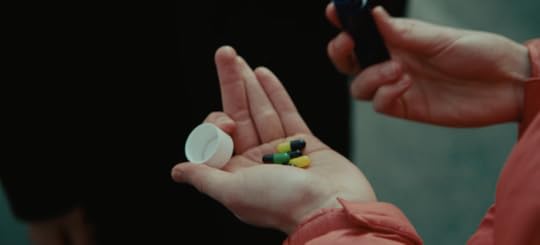 Why does the Old Man come out of a shed in the opening of the film? What is happening there?The Old Man keeps his pill supply in a shed, far from his main house. This shed is glimpsed in the beginning of the film when he emerges from it holding a capsule-looking silver cannister. That cannister is seen later in the main house, filled to the rim with pills. When the students later break into the main house, they tragically cannot find any more pills because they do not know they are truly hidden in the shed.
Why does the Old Man come out of a shed in the opening of the film? What is happening there?The Old Man keeps his pill supply in a shed, far from his main house. This shed is glimpsed in the beginning of the film when he emerges from it holding a capsule-looking silver cannister. That cannister is seen later in the main house, filled to the rim with pills. When the students later break into the main house, they tragically cannot find any more pills because they do not know they are truly hidden in the shed.
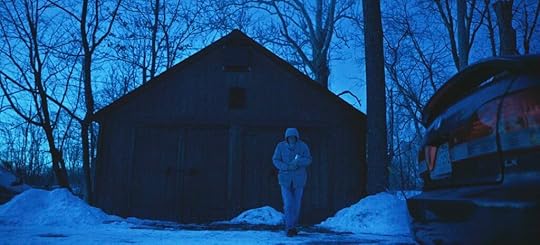 Where do the pills come from originally? What substance are they made of?The Old Man discovered the substance that he would later synthesize into the pills in 1968 when he came across a large green-shimmering rock originally from outer space that crash landed in a far-off, unnamed desert. This event is shown chronologically last in the film, as a post-credits scene. Maya also learns about this when she decrypts his journal, and she tells Dev about it in the final scene right before the credits. Jasper attempts to understand the chemical composition of the pills, but he discovers that they are not present on the periodic table of elements. This points to dark matter resonance, explained in the next question.How are the pills’ chemical components not on the periodic table? Could there be more, undiscovered (maybe extraterrestrial) chemical elements that would disrupt our current understanding?For something new to disrupt the table, we would need to discover a novel, unexpected form of matter, which our fundamental theories don’t anticipate. Could it happen? I mean, sure. Our theories are incomplete. Nature could always prove us wrong. In ten thousand years, maybe we find some dark matter resonance that ends up behaving like hadronic matter. But do we expect that to happen? Not particularly.What did the Old Man do with the rock from outer space? How did he fashion the pills?The audience is left to imagine that between 1968 and 2018, the Old Man conducted experiments on the substance that led to the pills. What exactly happened is left entirely to the audience’s imagination. The director and writers of the film believed that the Old Man discovered the substance and was a perfectionist who was unwilling to share his discovery with the world. As a result, he hid his research and conducted it off the grid. Ultimately, he moved into the town and unknowingly doomed himself. The town’s polluted air led to an unexpected adverse reaction that proved lethal. More on that in the next bullet.How did the Old Man doom himself? What is going on with the adverse reaction of the pills? Why does one “comedown” and then die while taking them?The Old Man moved to a town containing a high parts per million concentration of air pollutants. These pollutants reacted with the substance in the pills to create an adverse “come down reaction” that the characters Dev, Jasper, Maya and Ryan experience in the film. Previously, the Old Man was studying the pills’ effects on himself, but they did not have a lethal dimension. By moving to the town, the Old Man essentially trapped himself. He would have then been stuck in a loop, continually taking the pills to survive. Perhaps he could have left the town like the students eventually do, but he may be imposing a Promethean fate upon himself and “suffering in silence” as we see in the film…
Where do the pills come from originally? What substance are they made of?The Old Man discovered the substance that he would later synthesize into the pills in 1968 when he came across a large green-shimmering rock originally from outer space that crash landed in a far-off, unnamed desert. This event is shown chronologically last in the film, as a post-credits scene. Maya also learns about this when she decrypts his journal, and she tells Dev about it in the final scene right before the credits. Jasper attempts to understand the chemical composition of the pills, but he discovers that they are not present on the periodic table of elements. This points to dark matter resonance, explained in the next question.How are the pills’ chemical components not on the periodic table? Could there be more, undiscovered (maybe extraterrestrial) chemical elements that would disrupt our current understanding?For something new to disrupt the table, we would need to discover a novel, unexpected form of matter, which our fundamental theories don’t anticipate. Could it happen? I mean, sure. Our theories are incomplete. Nature could always prove us wrong. In ten thousand years, maybe we find some dark matter resonance that ends up behaving like hadronic matter. But do we expect that to happen? Not particularly.What did the Old Man do with the rock from outer space? How did he fashion the pills?The audience is left to imagine that between 1968 and 2018, the Old Man conducted experiments on the substance that led to the pills. What exactly happened is left entirely to the audience’s imagination. The director and writers of the film believed that the Old Man discovered the substance and was a perfectionist who was unwilling to share his discovery with the world. As a result, he hid his research and conducted it off the grid. Ultimately, he moved into the town and unknowingly doomed himself. The town’s polluted air led to an unexpected adverse reaction that proved lethal. More on that in the next bullet.How did the Old Man doom himself? What is going on with the adverse reaction of the pills? Why does one “comedown” and then die while taking them?The Old Man moved to a town containing a high parts per million concentration of air pollutants. These pollutants reacted with the substance in the pills to create an adverse “come down reaction” that the characters Dev, Jasper, Maya and Ryan experience in the film. Previously, the Old Man was studying the pills’ effects on himself, but they did not have a lethal dimension. By moving to the town, the Old Man essentially trapped himself. He would have then been stuck in a loop, continually taking the pills to survive. Perhaps he could have left the town like the students eventually do, but he may be imposing a Promethean fate upon himself and “suffering in silence” as we see in the film…
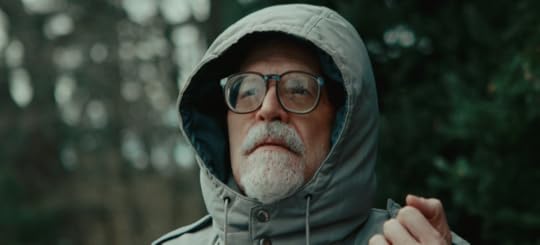 Why does the Old Man never speak?The Old Man is deaf and mute. Many audience members seem to miss this detail. It is briefly shown when Dev interrogates the Old Man, and we see her from his perspective for a moment. She is yelling at him, but no words are coming out of her mouth. He cannot hear her. This deaf and mute aspect plays into the debacle that happens during the break-in. The Old Man does not actually know that the students have taken the pills in the first place. He is trying to do an altruistic act and prevent them from experiencing the pills’ deadly effects when he flushes them down the toilet. This adds an element of tragedy to the events in the film, for if he had known they needed the pills, he would have given them over to them.How do some of the students survive at the end?The pills become fatal when they are ingested and the person who ingested them is in the presence of high levels of pollution. This causes a chemical reaction that leads to their lung failure. Upon hearing from Ryan that he missed his comedown period when chasing for Jasper in the foothills, Dev (having learned that there were lung effects from the pills after dissecting the Old Man) rightfully hypothesizes that the pills’ comedown reaction may be reduced or nullified when the person taking them is in the presence of fresh air. The students test Dev’s hypothesis by driving far away from the town into remote nature. It turns out to be true, and they live.
Why does the Old Man never speak?The Old Man is deaf and mute. Many audience members seem to miss this detail. It is briefly shown when Dev interrogates the Old Man, and we see her from his perspective for a moment. She is yelling at him, but no words are coming out of her mouth. He cannot hear her. This deaf and mute aspect plays into the debacle that happens during the break-in. The Old Man does not actually know that the students have taken the pills in the first place. He is trying to do an altruistic act and prevent them from experiencing the pills’ deadly effects when he flushes them down the toilet. This adds an element of tragedy to the events in the film, for if he had known they needed the pills, he would have given them over to them.How do some of the students survive at the end?The pills become fatal when they are ingested and the person who ingested them is in the presence of high levels of pollution. This causes a chemical reaction that leads to their lung failure. Upon hearing from Ryan that he missed his comedown period when chasing for Jasper in the foothills, Dev (having learned that there were lung effects from the pills after dissecting the Old Man) rightfully hypothesizes that the pills’ comedown reaction may be reduced or nullified when the person taking them is in the presence of fresh air. The students test Dev’s hypothesis by driving far away from the town into remote nature. It turns out to be true, and they live.
 Trivia TidbitsThe main house in the film was owned by Joyce Carol Oates for many years. One can read her writing about the home’s mystique here: https://celestialtimepiece.com/2010/02/23/9-honeybrook-drive/All cast and crew, except for who played the Old Man, were under 25 years old during the production of the film.The first complete scene filmed was the dissection scene.The final complete scene filmed was the film’s finale on the waterfall. smoked herbal prop cigarettes for the film, while smoked real cigarettes.Ryan’s laptop has a sticky note on it that displays the chemical formulation for hallucinogenic “magic” mushrooms.The title cards displaying the passage of time are a tribute to Kubrick’s usage of similar title cards in The Shining.Jasper can be seen wearing mala beads, common in the Buddhist tradition.Dev can be seen wearing a miraculous medal and Catholic rosary beads on her wrist throughout the film.The artwork on display in Dev’s Bedroom, including the bodhisattva (Buddhist Saint) and the Mountain Range were made by Luke Momo.The vomit in the film was made of oatmeal and green food coloring.The cinematographer shot a movie after this called Cannibal Mukbang that deployed the exact same chest cavity prop featured in the film, made by Ashley K. Thomas of Yellow Moth Makeup.About the Artist
Trivia TidbitsThe main house in the film was owned by Joyce Carol Oates for many years. One can read her writing about the home’s mystique here: https://celestialtimepiece.com/2010/02/23/9-honeybrook-drive/All cast and crew, except for who played the Old Man, were under 25 years old during the production of the film.The first complete scene filmed was the dissection scene.The final complete scene filmed was the film’s finale on the waterfall. smoked herbal prop cigarettes for the film, while smoked real cigarettes.Ryan’s laptop has a sticky note on it that displays the chemical formulation for hallucinogenic “magic” mushrooms.The title cards displaying the passage of time are a tribute to Kubrick’s usage of similar title cards in The Shining.Jasper can be seen wearing mala beads, common in the Buddhist tradition.Dev can be seen wearing a miraculous medal and Catholic rosary beads on her wrist throughout the film.The artwork on display in Dev’s Bedroom, including the bodhisattva (Buddhist Saint) and the Mountain Range were made by Luke Momo.The vomit in the film was made of oatmeal and green food coloring.The cinematographer shot a movie after this called Cannibal Mukbang that deployed the exact same chest cavity prop featured in the film, made by Ashley K. Thomas of Yellow Moth Makeup.About the ArtistBorn in Princeton, NJ, Luke earned his undergraduate degree in philosophy with a minor in visual arts from Fordham College Lincoln Center in the Class of 2019. As a student, he founded the Fordham Filmmaking Club. As a filmmaker, he directed Capsules, a feature film, alongside a series of short films including “The Stamp Collector.” He also interned for Marie-Louise Khondji at Le Cinema Club, a dynamic online cinema space.
The post Guest Post: Capsules Movie Explained (with Spoilers) and Trivia Tidbits by Luke Momo appeared first on L. Andrew Cooper's Horrific Scribblings.



